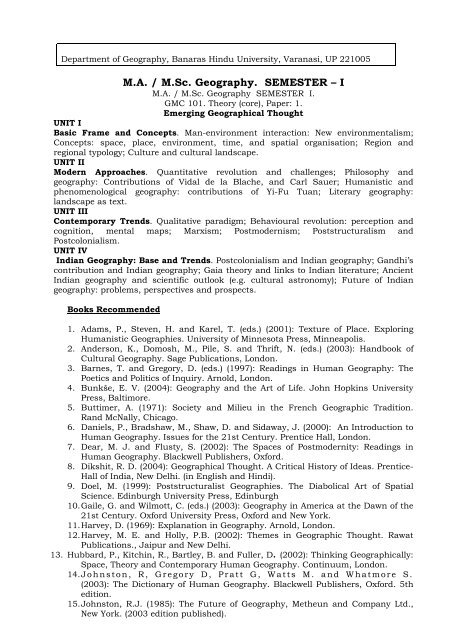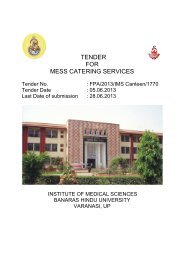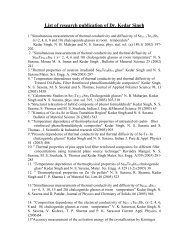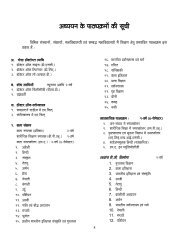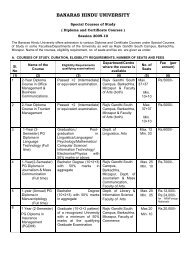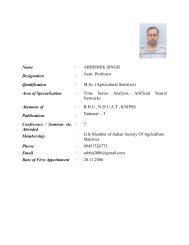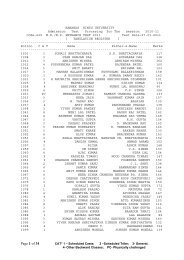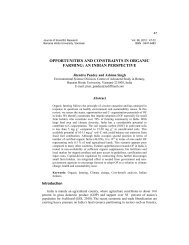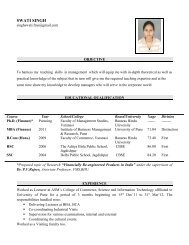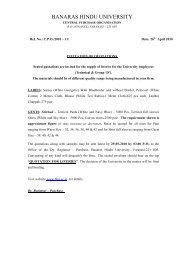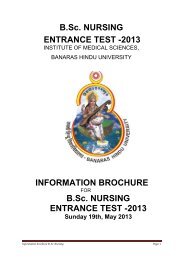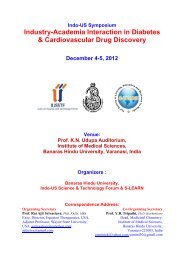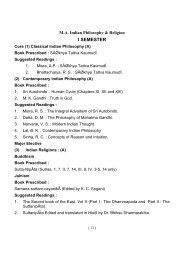Department of Geography, Banaras Hindu University, Varanasi, UP ...
Department of Geography, Banaras Hindu University, Varanasi, UP ...
Department of Geography, Banaras Hindu University, Varanasi, UP ...
You also want an ePaper? Increase the reach of your titles
YUMPU automatically turns print PDFs into web optimized ePapers that Google loves.
<strong>Department</strong> <strong>of</strong> <strong>Geography</strong>, <strong>Banaras</strong> <strong>Hindu</strong> <strong>University</strong>, <strong>Varanasi</strong>, <strong>UP</strong> 221005<br />
M.A. / M.Sc. <strong>Geography</strong>. SEMESTER – I<br />
M.A. / M.Sc. <strong>Geography</strong> SEMESTER I.<br />
GMC 101. Theory (core), Paper: 1.<br />
Emerging Geographical Thought<br />
UNIT I<br />
Basic Frame and Concepts. Man-environment interaction: New environmentalism;<br />
Concepts: space, place, environment, time, and spatial organisation; Region and<br />
regional typology; Culture and cultural landscape.<br />
UNIT II<br />
Modern Approaches. Quantitative revolution and challenges; Philosophy and<br />
geography: Contributions <strong>of</strong> Vidal de la Blache, and Carl Sauer; Humanistic and<br />
phenomenological geography: contributions <strong>of</strong> Yi-Fu Tuan; Literary geography:<br />
landscape as text.<br />
UNIT III<br />
Contemporary Trends. Qualitative paradigm; Behavioural revolution: perception and<br />
cognition, mental maps; Marxism; Postmodernism; Poststructuralism and<br />
Postcolonialism.<br />
UNIT IV<br />
Indian <strong>Geography</strong>: Base and Trends. Postcolonialism and Indian geography; Gandhi’s<br />
contribution and Indian geography; Gaia theory and links to Indian literature; Ancient<br />
Indian geography and scientific outlook (e.g. cultural astronomy); Future <strong>of</strong> Indian<br />
geography: problems, perspectives and prospects.<br />
Books Recommended<br />
1. Adams, P., Steven, H. and Karel, T. (eds.) (2001): Texture <strong>of</strong> Place. Exploring<br />
Humanistic Geographies. <strong>University</strong> <strong>of</strong> Minnesota Press, Minneapolis.<br />
2. Anderson, K., Domosh, M., Pile, S. and Thrift, N. (eds.) (2003): Handbook <strong>of</strong><br />
Cultural <strong>Geography</strong>. Sage Publications, London.<br />
3. Barnes, T. and Gregory, D. (eds.) (1997): Readings in Human <strong>Geography</strong>: The<br />
Poetics and Politics <strong>of</strong> Inquiry. Arnold, London.<br />
4. Bunkše, E. V. (2004): <strong>Geography</strong> and the Art <strong>of</strong> Life. John Hopkins <strong>University</strong><br />
Press, Baltimore.<br />
5. Buttimer, A. (1971): Society and Milieu in the French Geographic Tradition.<br />
Rand McNally, Chicago.<br />
6. Daniels, P., Bradshaw, M., Shaw, D. and Sidaway, J. (2000): An Introduction to<br />
Human <strong>Geography</strong>. Issues for the 21st Century. Prentice Hall, London.<br />
7. Dear, M. J. and Flusty, S. (2002): The Spaces <strong>of</strong> Postmodernity: Readings in<br />
Human <strong>Geography</strong>. Blackwell Publishers, Oxford.<br />
8. Dikshit, R. D. (2004): Geographical Thought. A Critical History <strong>of</strong> Ideas. Prentice-<br />
Hall <strong>of</strong> India, New Delhi. (in English and Hindi).<br />
9. Doel, M. (1999): Poststructuralist Geographies. The Diabolical Art <strong>of</strong> Spatial<br />
Science. Edinburgh <strong>University</strong> Press, Edinburgh<br />
10. Gaile, G. and Wilmott, C. (eds.) (2003): <strong>Geography</strong> in America at the Dawn <strong>of</strong> the<br />
21st Century. Oxford <strong>University</strong> Press, Oxford and New York.<br />
11. Harvey, D. (1969): Explanation in <strong>Geography</strong>. Arnold, London.<br />
12. Harvey, M. E. and Holly, P.B. (2002): Themes in Geographic Thought. Rawat<br />
Publications., Jaipur and New Delhi.<br />
13. Hubbard, P., Kitchin, R., Bartley, B. and Fuller, D. (2002): Thinking Geographically:<br />
Space, Theory and Contemporary Human <strong>Geography</strong>. Continuum, London.<br />
14. Johnston, R, Gregory D, Pratt G, Watts M. and Whatmore S.<br />
(2003): The Dictionary <strong>of</strong> Human <strong>Geography</strong>. Blackwell Publishers, Oxford. 5th<br />
edition.<br />
15. Johnston, R.J. (1985): The Future <strong>of</strong> <strong>Geography</strong>, Metheun and Company Ltd.,<br />
New York. (2003 edition published).
16. Johnston, R.J. and Sidaway, J.D. (2004): <strong>Geography</strong> and Geographers. 6 th<br />
edition, Edward Arnold, London.<br />
17. Kapur, A. (ed.) (2001): Indian <strong>Geography</strong> – Voice <strong>of</strong> Concern. Concept Publishing.<br />
Company, New Delhi.<br />
18. Martin, G. (2005): All Possible Worlds. A History <strong>of</strong> Geographical Ideas. 4 th<br />
edition, Oxford <strong>University</strong> Press, New York.<br />
19. Mathews, J. A. and Herbert, D. T. (eds.) (2004): Unifying <strong>Geography</strong>. Common<br />
Heritage, Shared Future. Routledge, London.<br />
20. Peet, R. (1998): Modern Geographical Thought. Blackwell Publishers Inc,<br />
Massachusetts.<br />
21. Sack, R. D. (ed.) (2002): Progress. Geographical Essays. John Hopkins <strong>University</strong><br />
Press, Baltimore.<br />
22. Sauer, C. O. (1963): Land and Life. <strong>University</strong> <strong>of</strong> California Press, Berkeley.<br />
23. Singh, R. L. and Singh, Rana P.B. (eds.) (1990): Literature and Humanistic<br />
<strong>Geography</strong>. National Geographical Society <strong>of</strong> India, BHU, <strong>Varanasi</strong>, Publication<br />
number 37<br />
24. Singh, R. L. and Singh, Rana P.B. (eds.) (1992): The Roots <strong>of</strong> Indian <strong>Geography</strong>:<br />
Search and Research. National Geographical Society <strong>of</strong> India, B.H.U., <strong>Varanasi</strong>,<br />
Publication number 39.<br />
25. Singh, Rana P.B. (ed.) (1993): Environmental Ethics. National Geographical.<br />
Society <strong>of</strong> India, BHU, <strong>Varanasi</strong>, Publication number 40.<br />
26. Singh, Rana P.B. (ed.) (1994): The Spirit and Power <strong>of</strong> Place. National<br />
Geographical Society <strong>of</strong> India, BHU, <strong>Varanasi</strong>, Publication number 41.<br />
27. Singh, Rana P. B. (2004): Cultural Landscapes and the Lifeworld. Indica Books,<br />
<strong>Varanasi</strong>.<br />
28. Soja, E. (1989): Post-modern Geographies. Verso Press, London. Reprinted 1997:<br />
Rawat Publications, Jaipur and New Delhi.<br />
29. Taylor, G. (ed.) (1953): <strong>Geography</strong> in the Twentieth Century.Methuen and<br />
Company Ltd. and Company, London.<br />
30. Tuan, Yi-Fu (1977): Space and Place. The Perspective <strong>of</strong> Experience. Edward<br />
Arnold, London.<br />
M.A. / M.Sc. <strong>Geography</strong> SEMESTER I<br />
GMC102. Theory (core), Paper: 2.<br />
Physical Landscape and Hydrology<br />
UNIT I<br />
Bases <strong>of</strong> Physical Landscape. Concept and types <strong>of</strong> physical landscape; Significance <strong>of</strong><br />
geomorphic processes including plate tectonics in landforms development; Geological<br />
structure and climatic factors in the development <strong>of</strong> landforms.<br />
UNIT II<br />
Landforms Development. Interruption in the evolution <strong>of</strong> landforms: tectonic,<br />
climatic, and base-level changes; Development <strong>of</strong> landforms in various areas: humid,<br />
coastal, karsts, and peri-glacial; River terraces: concept and types; Regional<br />
geomorphology: Indo-Gangatic plain, and Rajmahal Hills.<br />
UNIT III<br />
Bases <strong>of</strong> Hydrology. Meaning, scope and development <strong>of</strong> Hydrology; Hydrological<br />
cycle; Man’s influence on the hydrological cycle; Precipitation types, characteristics and<br />
measurements; Evaporation: factors affecting evaporation from free water surface and<br />
soil; Evapotranspiration: estimation and its control.<br />
UNIT IV<br />
Water and Its Disposition. Soil moisture and its zones; Infiltration; Groundwater:<br />
occurrence, storage, recharge and discharge; Run<strong>of</strong>f: its sources and components,<br />
factors affecting run<strong>of</strong>f; River regimes; Hydrograph: components and separation.<br />
Books Recommended<br />
1. Bernhard, H. and James, M. A. (1944): Climatology. McGraw Hill Company, New<br />
York.<br />
2
2. Chorley, R. J. (1995): Atmosphere, Weather and Climate.Methuen and<br />
Company Ltd. and Company Ltd., London.<br />
3. Chow, V. T., (ed.) (1954): Handbook <strong>of</strong> Applied Hydrology: A Compendium <strong>of</strong><br />
Water Resources Technology. McGraw Hill, New York.<br />
4. Critchfield, H. J. (2003): General Climatology. Prentice-Hall <strong>of</strong> India, New Delhi.<br />
5. Rai, V.K.(1993): Water Resource Planning and Development, Deep and Deep<br />
Publication, New Delhi<br />
6. Bilas, R. (1988): Rural Water Resource Utilization and Planning. Concept<br />
Publishing Company, New Delhi.<br />
7. Reddy, J. P. (1988): A Textbook <strong>of</strong> Hydrology. Laxmi Publication., New Delhi. 4 th<br />
edition.<br />
8. Singh, M. B. (1999): Climatology and Hydrology. Tara Book Agency, <strong>Varanasi</strong>.<br />
(In Hindi).<br />
9. Singh, M. B. (2002): Physical <strong>Geography</strong>. Tara Book Agency, <strong>Varanasi</strong>. (In<br />
Hindi).<br />
10. Singh, S., (1998): Geomorphology. Prayag Pustak Bhavan, Allahabad.<br />
11. Sparks, B.W., (1986): Geomorphology. Longman, London.<br />
12. Thornbury, W.D., (2005): Principles <strong>of</strong> Geomorphology. John Wiley and Sons,<br />
New York.<br />
13. Trewartha, G. T. (1980): An Introduction to Climatology. McGraw Hill Student<br />
edition, New York.<br />
14. Ward, R.C. and Robinson, M. (2000): Principles <strong>of</strong> Hydrology. McGraw Hill, New<br />
York.<br />
15. Weisberg, J. S. (1974): Meteorology. Houghton Miffin Company, Boston.<br />
16. Wooldridge, S.W. and Morgan, R.S. (1959): The Physical Basis <strong>of</strong> <strong>Geography</strong>- An<br />
Outline <strong>of</strong> Geomorphology. Longmans Green, London.<br />
M.A. / M.Sc. <strong>Geography</strong> SEMESTER I.<br />
GMC103. Theory (core) Paper: 3<br />
Advanced <strong>Geography</strong> <strong>of</strong> India<br />
UNIT I<br />
Introduction. Making <strong>of</strong> India through geological times, structure and relief; Drainage<br />
systems and watersheds; Physiographic divisions; Climate characteristics: mechanism<br />
<strong>of</strong> the Indian Monsoon; Forests: types, distribution and utilisation.<br />
UNIT II<br />
Population Characteristics. Population growth: trends and pattern; Population:<br />
distribution and density; Ageing <strong>of</strong> population; Sex and literacy differentials; Ethnic<br />
groups; Trends <strong>of</strong> urbanisation; National population policy - 2000.<br />
UNIT III<br />
Agricultural Scene. Agricultural characteristics and trends; Land holdings, land<br />
tenure, land consolidation and land reforms; Infrastructure: irrigation, power, fertiliser,<br />
HYV seeds and farm technology; Green, white, blue and yellow revolutions.<br />
UNIT IV<br />
Industrial Resource Base. Regional distribution and development potentials <strong>of</strong> mineral<br />
and power resources; New industrial policy: Globalisation and liberalisation; Industrial<br />
complexes and industrial regions; Transport development: rail and road; Geographical<br />
regions; Detailed study <strong>of</strong> the Middle Ganga plain and Karnataka plateau region.<br />
Books Recommended.<br />
1. Chapman, G. and Baker, K.M. (eds.) (1992): The Changing <strong>Geography</strong> <strong>of</strong> Asia.<br />
Routledge, London.<br />
2. Farmer, B.H. (1983): Introduction to South Asia. Methuen and Company Ltd.<br />
and Company Ltd., London.<br />
3. Ganguly, S. nd Neil, DeVotta (eds.) (2003): Understanding Contemporary India.<br />
Lynne Reinner Publishers., Boulder and London.<br />
4. Gole, P. N. (2001): Nature Conservation and Sustainable Development in India.<br />
Rawat publications, Jaipur and New Delhi.<br />
3
5. Johnson, B. L. C. (ed.) (2001): Geographical Dictionary <strong>of</strong> India. Vision<br />
Books, New Delhi.<br />
6. Johnson, B.L.C. (1983): Development in South Asia. Penguin Books,<br />
Harmonsworth.<br />
7. Khullar, D. R. (2006): India. A Comprehensive <strong>Geography</strong>. Kalyani Publishers.,<br />
New Delhi.<br />
8. Krishnan, M. S. (1968): Geology <strong>of</strong> India and Burma. 4 th edition. Higgin Bothams<br />
Private. Ltd., Madras.<br />
9. Nag, P. and Gupta S. S. (1992): <strong>Geography</strong> <strong>of</strong> India. Concept Publishing.<br />
Company, New Delhi.<br />
10. Sharma, T. C. (2003): India: Economic and Commercial <strong>Geography</strong>. Vikas<br />
Publication., New Delhi.<br />
11. Singh, J. (2003): India: A Comprehensive and Systematic <strong>Geography</strong>. Gyanodaya<br />
Prakashan, Gorakhpur.<br />
12. Singh, R. L. (ed.) (1971): India. A Regional <strong>Geography</strong>. National Geographical<br />
Society <strong>of</strong> India, <strong>Varanasi</strong>.<br />
13. Spate, O.H.K., Learmonth, A.T.A. and Farmer, B. H. (1979): India and<br />
Pakistan.Methuen and Company Ltd. and Company Ltd., London.<br />
14. Subbarao, B. (1959): The Personality <strong>of</strong> India. <strong>University</strong> <strong>of</strong> Baroda Press,<br />
Baroda.<br />
15. Sukhwal, B.L. (1987): India. Economic Resource Base and Contemporary<br />
Political Patterns. Sterling Publication, New Delhi.<br />
16. Tirtha, R. (2002): <strong>Geography</strong> <strong>of</strong> India. Rawat Publications., Jaipur and New<br />
Delhi.<br />
17. Tiwari, R. C. (2007): <strong>Geography</strong> <strong>of</strong> India, Prayag Pustak Bhawan, Allahabad<br />
18. Wadia, D. N. (1959): Geology <strong>of</strong> India. MacMillan and Company, London and<br />
Madras. Student edition.<br />
M.A. / M.Sc. <strong>Geography</strong> SEMESTER I<br />
GMP 104. Practical (core), Paper: 1.<br />
Physical Diagrams, Hydrology and Map Projections<br />
1. Physical Diagrams and Hydrology. Advanced exercises on geological maps:<br />
folded and faulted structures, unconformable rock series; Hypsographic and<br />
clinographic curves; Drainage basin analysis; Drawing <strong>of</strong> climatological water balance<br />
graph and determination <strong>of</strong> the components; Calculation <strong>of</strong> climatic indices: rainfallrun<strong>of</strong>f<br />
relationship; Hydro-graphs: components and separation; Unit hydrograph.<br />
2. Map Projections. Determination <strong>of</strong> azimuth, retro-azimuth and great circle<br />
distances on the earth: Construction <strong>of</strong> comparative scales for graticules on Mercator’s<br />
and Gall’s projections; Determination <strong>of</strong> percentage <strong>of</strong> error in scale and area on<br />
selected projections.<br />
M.A. / M.Sc. <strong>Geography</strong> SEMESTER I.<br />
GMP 105. Practical (core), Paper: 2.<br />
Spatial Analysis: Locational and Network<br />
1. Locational Analysis. Absolute and relative location: spacing, indices <strong>of</strong><br />
randomness, deviation and nature <strong>of</strong> dispersion; Nodes-population clusters: the size<br />
continuum, size and shape; Hierarchies: functional hierarchy <strong>of</strong> settlements and<br />
ordering; Interaction: movement and distance models; Service area and territory – serial<br />
polygons, interactions zones; Case <strong>of</strong> agricultural and industrial location.<br />
2. Network Analysis. Topologic structures: branching, circuit and barrier<br />
networks; Geometric structures: Networks shape and density, pattern and order; Flow<br />
and network efficiency; Location <strong>of</strong> network routes and boundaries; Pattern <strong>of</strong> spatial<br />
evolution and network transformation.<br />
4
M.A. / M.Sc. <strong>Geography</strong> SEMESTER I.<br />
GMM 501. Elective (Minor) Theory, Paper: 1.<br />
Remote Sensing Basics<br />
UNIT I<br />
Fundamentals. Remote sensing: definition and scope; Electro-magnetic radiation:<br />
characteristics, interaction with matter, Remote sensing regions and bands; Types <strong>of</strong><br />
remote sensing.<br />
UNIT II<br />
Aerial Photographs. Aerial photos: types, scale, resolution; Geometric properties <strong>of</strong><br />
single aerial photos; Stereoscopy; Interior and exterior elements <strong>of</strong> orientation;<br />
Stereoscopic parallax; Relief displacement.<br />
UNIT III<br />
Satellite Imagery. General orbital characteristics <strong>of</strong> remote sensing satellites; General<br />
characteristics <strong>of</strong> remote sensing sensors; Characteristics <strong>of</strong> MSS, HRV, LISS;<br />
Characteristics <strong>of</strong> raw remote sensing data.<br />
UNIT IV<br />
Interpretation and Application. Elements <strong>of</strong> image interpretation; Image processing<br />
techniques: Visual and digital; Remote sensing data: pre-processing operations,<br />
enhancements and classifications; Remote sensing in resource mapping and<br />
environmental monitoring.<br />
Books Recommended<br />
1. Campbell, J. B. (2002): Introduction to Remote Sensing. 5 th edition. Taylor and<br />
Francis, London.<br />
2. Cracknell, A and Hayes, L. (1990): Remote Sensing Year Book, Taylor and<br />
Francis, London.<br />
3. Curran, P.J. (1985): Principles <strong>of</strong> Remote Sensing, Longman, London.<br />
4. Deekshatulu, B.L. and Rajan, Y.S. (ed.) (1984): Remote Sensing. Indian Academy<br />
<strong>of</strong> Science, Bangalore.<br />
5. Floyd, F. and Sabins, Jr. (1986): Remote Sensing: Principles and Interpretation,<br />
W.H. Freeman, New York.<br />
6. Guham, P. K. (2003): Remote Sensing for Beginners. Affiliated East-West Press<br />
Private Ltd., New Delhi.<br />
7. Hallert, B. (1960): Photogrammetry, McGraw Hill Book Company Inc., New York<br />
8. Harry, C.A. (ed.) (1978): Digital Image Processing, IEEE Computer Society,<br />
California<br />
9. Hord, R.M. (1982): Digital Image Processing <strong>of</strong> Remotely Sensed Data, Academic<br />
Press, New York.<br />
10. Leuder, D.R. (1959): Aerial Photographic Interpretation: Principles and<br />
Application. McGraw Hill, New York.<br />
11. Lillesand, T.M. and Kiefer, R.W. (2000): Remote Sensing and Image<br />
Interpretation. 4 th edition. John Wiley and Sons, New York.<br />
12. Nag, P. (ed.) 1992: Thematic Cartography and Remote Sensing, Concept<br />
Publishing. Company, New Delhi.<br />
13. Reeves, R.G. (ed.) (1983): Manual <strong>of</strong> Remote Sensing, Vols. 1 and 2, American<br />
Society <strong>of</strong> Photogrammetry and Remote Sensing, Falls Church, Virginia.<br />
14. Siegel, B.S. and Gillespie, R. (1985): Remote Sensing in Geology, John Wiley and<br />
Sons, New York.<br />
15. Silver, M. and Balmori, D. (eds.) (2003): Mapping in an Age <strong>of</strong> Digital Media.<br />
Wiley-Academy, New York and Chichester.<br />
16. Spurr, R. (1960): Photogrammetry and Photo Interpretation, The Roland Press<br />
Company, London.<br />
17. Survey <strong>of</strong> India, (1973): Photogrammetry, Survey <strong>of</strong> India, Dehradun.<br />
18. Swain, P.H. and Davis, S.M. (ed.), (1978): Remote Sensing: The Quantitative<br />
Approach. McGraw Hill, New York.<br />
5
M.A. / M.Sc. <strong>Geography</strong> SEMESTER I.<br />
GMS 601. Seminar (Core): 1. Assignment Based Seminar<br />
<strong>Department</strong> <strong>of</strong> <strong>Geography</strong>, <strong>Banaras</strong> <strong>Hindu</strong> <strong>University</strong><br />
M.A. / M.Sc. <strong>Geography</strong> SEMESTER II<br />
M.A. / M.Sc. <strong>Geography</strong> SEMESTER II<br />
GMC 106. Theory (core), Paper: 4.<br />
Advanced Geomorphology<br />
UNIT I<br />
Concepts. Recent observations on some fundamental concepts <strong>of</strong> geomorphology;<br />
Concept <strong>of</strong> time: cyclic, graded and steady state; Concept <strong>of</strong> morphogenetic region;<br />
Concept <strong>of</strong> dynamic equilibrium; Recent trends in geomorphology.<br />
UNIT II<br />
Drainage Basin and Related Aspects. Drainage basin as a geomorphic unit:<br />
morphometric laws; Denudation and morpho-chronology and dating <strong>of</strong> landscapes; Soil<br />
erosion and its measurement.<br />
UNIT III<br />
Theories and Techniques. Theories <strong>of</strong> hill-slope evolution; Erosion surfaces;<br />
Geomorphic mapping techniques; Systems in geomorphology; Models in<br />
geomorphology.<br />
UNIT IV<br />
Application in Various Fields. Geomorphic hazards and mitigation measures;<br />
Geomorphology and economic deposits; Geomorphology in engineering construction;<br />
Geomorphology in groundwater studies; Soils and geomorphology.<br />
Books Recommended<br />
1. Ahmed, E. (1985): Geomorphology. Kalyani Publishers, New Delhi.<br />
2. Bloom.A. L. (1998/ 2001): Geomorphology. 3 rd edition. Prentice Hall <strong>of</strong> India,<br />
New Delhi.<br />
3. Chorley, R.J., Schumm S A and Sugden D E. (1984): Geomorphology. Methuen<br />
and Company Ltd., London.<br />
4. Dayal, P. (1994): A Text Book <strong>of</strong> Geomorphology. Kalyani Publishers, New Delhi.<br />
5. Fairbridge, R.W. (ed.) (1968): Encyclopaedia <strong>of</strong> Geomorphology, Reinhold Book<br />
Corporation., New York<br />
6. Gregory, K.J. and Walling, D.E. (1973): Drainage Basin Form and Process.<br />
Edward Arnold, London.<br />
7. Jog, S. R. (ed.) (1995): Indian Geomorphology (2 vols.). Rawat Publications,<br />
Jaipur<br />
8. Kale, V. and Gupta, A. (2001): Introduction to Geomorphology. Orient Longman,<br />
Hyderabad.<br />
9. King, C.A.M. (1966): Techniques in Geomorphology. Edward Arnold, London.<br />
10. Pethick, J. (1984): An Introduction to Coastal Geomorphology. Arnold, London.<br />
Indian reprint 2000.<br />
11. Sharma, P. R. (ed.), (1993): Applied Geomorphology in Tropics. Rishi<br />
Publications, <strong>Varanasi</strong>.<br />
12. Singh, S. (2004): Geomorphology. Prayag Pustak Bhawan, Allahabad.<br />
13. Sparks, B.W. (1986): Geomorphology. Longmans, London.<br />
14. Thornbury, W.D. (2005): Principles <strong>of</strong> Geomorphology. John Wiley and Sons,<br />
New York.<br />
15. Wooldridge, S.W. and Morgan, R.S. (1959): The Physical Basis <strong>of</strong> <strong>Geography</strong>- An<br />
Outline <strong>of</strong> Geomorphology. Longman, London.<br />
6
M.A. / M.Sc. <strong>Geography</strong> SEMESTER II.<br />
GMC 107. Theory (core) Paper: 5.<br />
<strong>Geography</strong> <strong>of</strong> Resources<br />
UNIT I<br />
Introduction and Bases. Concept and scope <strong>of</strong> Resource <strong>Geography</strong>; Resource:<br />
concept and types; World resources: distribution and pattern; Land, water, mineral and<br />
power resources; Non-conventional sources <strong>of</strong> energy; Human resources; Resource base<br />
and its dynamism as related to stages <strong>of</strong> cultural, technological and economic<br />
development.<br />
UNIT II<br />
Resource Use. The limits to growth; Resource scarcity hypothesis; World energy crisis;<br />
Resource conservation and management; Watershed management; Sustainable<br />
development; Resources, development and international politics.<br />
UNIT III<br />
Theories <strong>of</strong> Resource Use. Theories <strong>of</strong> agricultural location; Theories <strong>of</strong> industrial<br />
location: Weber, Hoover, and Losch; Trade blocs.<br />
UNIT IV<br />
Regional Perspectives. Resource regionalisation; World economic development;<br />
Concept <strong>of</strong> developed and developing nations; Concepts <strong>of</strong> North-South and First,<br />
Second, Third and Fourth Worlds.<br />
Books Recommended<br />
1. Burton, I. and Kates, R.W. (1978): Readings in Resource Management and<br />
Conservation. McGraw Hills, New York<br />
2. Clark, G. L., Feldman, M.P. and Gertler, M.S. (eds.) (2000): The Oxford<br />
Handbook <strong>of</strong> Economic <strong>Geography</strong>. Oxford <strong>University</strong> Press, Oxford and New<br />
York.<br />
3. Ehrlich, P.R., Ehrlich, R.H. and Holdren, J.P. (1998): Ecoscience: Population,<br />
Resources and Development. 2 nd edition. Freeman and Company, San Francisco.<br />
4. Sheppard E. and Treror I. B. (ed.) (2003): A Companion to Economic <strong>Geography</strong>,<br />
Blackwell Publication, U.K. and USA.<br />
5. McCarty, H.M. and James B.L. (1976): A Preface to Economic <strong>Geography</strong>.<br />
Prentice Hall, New Jersey.<br />
6. Mitra, A. (2000): Resource Studies; Shridhar Publishers., Kolkata.<br />
7. Ramesh, A. (ed.) (1984): Resource <strong>Geography</strong>. Heritage Publishers, New Delhi.<br />
8. Singh, J. (2000): Sansadhan Bhoogol, Gyanodaya Prakashan, Gorakhpur<br />
9. Singh, K.N. and Singh, J. (2003): Arthik Bhoogol Ke Mool Tatva, Gyanodaya<br />
Prakashan, Gorakhpur.<br />
10. Todaro M.P. and Smith S.C. (2004): Economic Development, Pearson Education,<br />
(Singapore) Private Ltd. Singapore<br />
M.A. / M.Sc. <strong>Geography</strong> SEMESTER II.<br />
GMP 108. Practical (core), Paper: 3.<br />
Statistical Methods and Data Processing<br />
1. Statistical Methods. The normal frequency distribution curve and its<br />
characteristics; Curve fitting; Sampling procedures: random, stratified random,<br />
systematic and cluster; Test <strong>of</strong> significance: Chi-square test, Student’s t-test, F-test,<br />
Analysis <strong>of</strong> variance; Analysis <strong>of</strong> time series.<br />
2. Data Processing. Collection <strong>of</strong> data: methods, sources and types; Classification and<br />
tabulation <strong>of</strong> data; Data processing devices; Characteristics and component <strong>of</strong> a<br />
computer system; Computer languages; Retrieving and processing <strong>of</strong> data.<br />
7
M.A. / M.Sc. <strong>Geography</strong> SEMESTER II.<br />
GMM 502. Elective (Minor), Theory Paper: 2.<br />
Population and Development<br />
UNIT I<br />
Conceptual Frame. Population as resource; Population and development: a debate;<br />
Population and ecosystem; Demographic transition.<br />
UNIT II<br />
Historical Background and Characteristics. History <strong>of</strong> human population;<br />
Relationship between population, food and energy; Debate on The Limits to Growth;<br />
Population characteristics: developed and developing countries (case study <strong>of</strong> India).<br />
UNIT III<br />
Problems and Policies. Optimum population; Family welfare and planning; Population<br />
policies in developed and developing countries (case study <strong>of</strong> India).<br />
UNIT IV<br />
Population and Development Conflict. Concepts <strong>of</strong> rich and poor worlds and their<br />
global perspectives; Neo-Malthusian theory; Future perspectives: Growth scenario and<br />
relationship with development.<br />
Books Recommended<br />
1. Champion, T. (ed.) (1993): Population Matters. Paul Chapman, London.<br />
2. Ehrlich, P.R. and Ehrlich, A.H. (1996): Ecoscience: Population, Resources,<br />
Environment. 6 th edition, W.H. Freeman and Company, San Francisco.<br />
3. Firor, J. and Jacobsen, J. E. (2003): The Crowded Greenhouse: Population,<br />
Climatic Change and Creating a Sustainable World. Universities Press (India)<br />
Private. Ltd., Hyderabad.<br />
4. Haggett, P. (2001): <strong>Geography</strong>, A Modern Synthesis. 5 th edition, Harper and Row,<br />
New York.<br />
5. Hammett, C. (eds.) (1996): Social <strong>Geography</strong>: A Reader. Arnold, London.<br />
6. Meadow, D.H., Meadows D.L., Randers J., and Behrens W.W. III.(1973): The<br />
Limits to Growth. I Report <strong>of</strong> the Club <strong>of</strong> Rome. The New American Library, New<br />
York.<br />
7. Meadows, D.H., Meadows, D.L. and Randers, J. (1992): Beyond the Limits.<br />
Confronting Global Collapse, Envisioning a Sustainable Future. (A sequel to The<br />
Limits to Growth). Chelsa Green Publishers, Post Mills VT, USA.<br />
8. Mesarovic, M. and Pester, E. (1974): Mankind at the Turning Point. II Report <strong>of</strong><br />
the Club <strong>of</strong> Rome. The New American Library, New York.<br />
9. Middleton, N. and O’Keefe, P. (2001): Redefining Sustainable Development. Pluto<br />
Press, London.<br />
10. Ross, J. A. (ed.) (1982): International Encyclopaedia <strong>of</strong> Population. Free Press,<br />
New York.<br />
11. Sharma, P. R. (ed.) (1991): Perspectives on the Third World Development. Rishi<br />
Publications., <strong>Varanasi</strong>.<br />
12. Sharma, P. R. (ed.) (1994): Regional Policies and Development in the Third<br />
World. Rishi Publications, <strong>Varanasi</strong>.<br />
13. Simon, J. L. (1977): The Economics <strong>of</strong> Population Growth. Princeton <strong>University</strong>.<br />
Press, Princeton.<br />
14. Thakur, B. (ed.) (2004): Population, Resources and Development. Vol. II,<br />
Perspectives in Resource Management in Developing Countries. Concept<br />
Publishing. Company, New Delhi.<br />
15. Tinbergen, J. (1976): RIO. Reshaping the International Order. III Report <strong>of</strong> the<br />
Club <strong>of</strong> Rome. The New American Library, New York.<br />
16. U.N.C.E.D. (1987): Our Common Future. UNCED The Centre for Our Common<br />
Future, Geneva.<br />
M.A. / M.Sc. <strong>Geography</strong> SEMESTER II<br />
GMS 602. Seminar (Core and Major Elective): 2<br />
Assignment Based Seminar<br />
8
<strong>Department</strong> <strong>of</strong> <strong>Geography</strong>, <strong>Banaras</strong> <strong>Hindu</strong> <strong>University</strong><br />
M.A. / M.Sc. <strong>Geography</strong> SEMESTER III<br />
M.A. / M.Sc. <strong>Geography</strong> SEMESTER III<br />
GMC109. Theory (core), Paper: 6.<br />
GIS and Its Application<br />
UNIT I<br />
Evolution <strong>of</strong> GIS; Definition and scope <strong>of</strong> GIS; Components <strong>of</strong> GIS; Issues and trends in<br />
GIS<br />
UNIT II<br />
Geographical data products, types and characteristics; Implications <strong>of</strong> spherical and<br />
planar coordinate systems and their transformations in GIS; Georeferencing and<br />
implications <strong>of</strong> earth’s shape and datum in GIS.<br />
UNIT III<br />
Issues in digital representation <strong>of</strong> geographic data; Raster and Vector models for<br />
geographic data representation; GIS data standards—concepts and components; Digital<br />
Elevation Model (DEM): process, derivatives and applications.<br />
UNIT IV<br />
Remote sensing and GIS integration, GIS project design and planning methodologies;<br />
GIS data base management systems; GIS information products; Applications <strong>of</strong> GIS.<br />
Books Recommended<br />
1. Bonham, Carter G.F. (1995): Information Systems for Geoscientists – Modelling<br />
with GIS. Pergamon, Oxford.<br />
2. Burrough, P.A. and McDonnell, R. (1998): Principles <strong>of</strong> Geographic Information<br />
Systems. Oxford <strong>University</strong> Press, Oxford.<br />
3. Chang, K.T. (2003): Introduction to Geographic Information Systems. Tata<br />
McGraw Hill Publications Company, New Delhi.<br />
4. Chauniyal, D. D. (2004): Remote Sensing and Geographic Information Systems.<br />
(in Hindi). Sharda Pustak Bhawan, Allahabad.<br />
5. Demers, M. N. (2000): Fundamentals <strong>of</strong> Geographic Information Systems. John<br />
Wiley and Sons, Singapore.<br />
6. ESRI (1993): Understanding GIS. Redlands, USA<br />
7. Fraser Taylor, D.R. (1991): Geographic Information Systems. Pergamon Press,<br />
Oxford.<br />
8. George, J. (2003): Fundamentals <strong>of</strong> Remote Sensing. Universities Press Private<br />
Ltd, Hyderabad.<br />
9. Girard, M. C. and Girard, C. M. (2003): Processing <strong>of</strong> Remote Sensing Data.<br />
Oxford and IBH, New Delhi.<br />
10. Glen, E. M. and Harold, C. S. (1993): GIS Data Conversion Handbook. Fort<br />
Collins, Colorado, GIS Word Inc.<br />
11. Goodchild, M.F.; Park, B. O. and Steyaert, L. T. (eds.) (1993): Environmental<br />
Modelling with GIS. Oxford <strong>University</strong> Press, Oxford.<br />
12. Guptill, S.C., and Morrison, J.L. (1995): Elements <strong>of</strong> Spatial Data Quality.<br />
Elsevier/ Pergamon, Oxford.<br />
13. Heywood, I. (2003): An Introduction to Geographical Information Systems. 2 nd<br />
edition, Pearson Publishing Company, Singapore.<br />
14. Korte, G. M. (2002): The GIS Book. On Word Press: Thomson Learning, New<br />
York and Singapore.<br />
15. Lo, C.P. and Yeung, A. K. W. (2002): Concepts and Techniques <strong>of</strong> Geographic<br />
Information Systems. Prentice Hall <strong>of</strong> India, New Delhi.<br />
16. Longley, P. and Batty, M. (eds.) (1996): Spatial Analysis: Modelling in a GIS<br />
Environment. GeoInformation International, Cambridge.<br />
17. Longley, P., Goodchild, M.F., Maguire, D. and Rhind, D. (1999): Geographic<br />
Information Systems. Principles, Techniques, Management, Applications. John<br />
Wiley and Sons, New York.<br />
9
18. Maguirre, D. J.; Michael F. G. and David W. R. (1999): Geographical<br />
Information Systems: Principles and Application. Geo Information International,<br />
Vol.2, Longman Publication., New York.<br />
19. Martin, D. (1996): Geographic Information Systems: Socioeconomic Implications.<br />
Routledge, London.<br />
20. Michael F. G. and Karan K. K. (ed.) (1990): Introduction to GIS. NCGIA, Santa<br />
Barbara, California.<br />
21. Ralston, B. A. (2002): Developing GIS Solutions with Map Objects and Visual<br />
Basic. OnWord Press: Thompson Learning, New York and Singapore.<br />
22. Reddy, M. A. (2001): Textbook <strong>of</strong> Remote Sensing and Geographic Information<br />
Systems. B. S. Publications., Hyderabad.<br />
23. Ripple, W. J. (ed.) (1989): Fundamentals <strong>of</strong> Geographic Information Systems: A<br />
Compendium. ASPRS/ ACSM, Falls Church.<br />
24. Siddiqui, M.A. (2005): Introduction to Geographical Information Systems, Sharda<br />
Pustak Bhawan, Allahabad.<br />
25. Star, J. and Estes, J. (1990): Geographic Information Systems – An Introduction.<br />
Prentice-Hall, Englewood Cliffs, New Jersey.<br />
26. Worboys, M. F. (1995): GIS: A Computing Perspective. Taylor and Francis,<br />
London.<br />
M.A. / M.Sc. <strong>Geography</strong> SEMESTER III<br />
GMC110. Theory (core), Paper: 7.<br />
Environmental Studies<br />
UNIT I<br />
Bases. Meaning and scope <strong>of</strong> environmental geography; Approaches to study <strong>of</strong><br />
environment; Types <strong>of</strong> environment, Environment and society, Environment and<br />
development, Environmental perception and cognitive maps.<br />
UNIT II<br />
Biogeography and Ecosystem. Definition, scope and significance <strong>of</strong> biogeography;<br />
Basic ecological principles; Geo-biochemical cycles: carbon, nitrogen, oxygen and<br />
phosphorus cycles; Biome and biomass; World distribution <strong>of</strong> plants and animals;<br />
Biodiversity: depletion and conservation.<br />
UNIT III<br />
Hazards and Changes. Environmental hazards; Natural hazards: landslides, soil<br />
erosion, droughts and floods, earthquakes; Man-made hazards: technological hazards,<br />
global climatic changes, global warming, green house effects, ozone depletion,<br />
sedimentation in rivers and reservoirs.<br />
UNIT IV<br />
Pollution and Management. Environmental pollution: pollutants, sources and types <strong>of</strong><br />
pollution; Water, soil, air, and noise pollution; Solid waste disposal; Environmental<br />
pollution and health; Environmental education; Environmental impact analysis;<br />
Environmental monitoring and standards; Environmental policy and legislation;<br />
Environmental management.<br />
Books Recommended<br />
1. Anjuneyulu, Y. (2002): Environmental Impact Assessment Methodologies. B. S.<br />
Publications, Hyderabad.<br />
2. Anjuneyulu, Y. (2004): Introduction to Environmental Science. B. S.<br />
Publications, Hyderabad.<br />
3. Athavale, R. N. (2003): Water Harvesting and Sustainable Supply in India.<br />
Rawat Publications., Jaipur.<br />
4. Bilas, R. (1988): Rural Water Resource Utilization and Planning. Concept<br />
Publishing. Company, New Delhi.<br />
5. Blaikie, P., Cannon, T. and Davis, I. (eds.) (2004): At Risk: Natural Hazards,<br />
Peoples Vulnerability and Disasters. Routledge, London.<br />
6. Clarke, J. I., Curson, P., Kayastha S. L. and Nag P. (eds.) (1991): Population and<br />
Disaster. Basil Blackwell, USA<br />
10
7. Gautam, A. (2007): Environmental <strong>Geography</strong>, Sharda Pustak Bhawan,<br />
Allahabad<br />
8. Huggett, R. J. (1998): Fundamental <strong>of</strong> Biogeography. Routledge, London.<br />
9. Kayastha, S.L. and Kumra V.K. (1986): Environmental Studies. Tara Book<br />
Agency, <strong>Varanasi</strong>.<br />
10. Khoshoo, T. N. (1981): Environmental Concerns and Strategies. Ashish<br />
Publishing House, New Delhi<br />
11. Kumra, V.K. (1982): Kanpur City. A Study in Environmental Pollution. Tara<br />
Book Agency, <strong>Varanasi</strong>.<br />
12. Mathur, H. S. (2003): Essentials <strong>of</strong> Biogeography. Pointer Publication, Jaipur.<br />
13. Nag, P., Kumra, V.K. and Singh, J. (1990): <strong>Geography</strong> and Environmental<br />
Issues at Local, Regional and National Levels. (in 3 vols.), Concept Publishing<br />
Company, New Delhi.<br />
14. Odum, E.P. (1975): Ecology. Rowman and Littlefield, Lanham USA.<br />
15. Rajagopalan, R. (2005): Environmental Studies: From Crisis to Cure, Oxford<br />
<strong>University</strong> Press, New Delhi.<br />
16. Reddy, M. A. (2004): Geoinformatics for Environmental Management. B. S.<br />
Publishers., Hyderabad.<br />
17. Saxena, K.K. (2004): Environmental Studies. <strong>University</strong> Book House Private<br />
Ltd., Jaipur<br />
18. Saxena, H. M. (1999): Environmental <strong>Geography</strong>. Rawat Publications., Jaipur<br />
and New Delhi.<br />
19. Saxena, H. M. (2000): Environmental Management. Rawat Publications., Jaipur<br />
and New Delhi.<br />
20. Singh, A.K., Kumra, V.K. and Singh, J. (1986): Forest Resource, Economy and<br />
Environment. Concept Publishing. Company, New Delhi.<br />
21. Singh, D.N., Singh, J. and Raju, K.N.P. (eds.) (2003): Water Crisis and<br />
Sustainable Management, Tara Book Agency, <strong>Varanasi</strong><br />
22. Singh, J. (2001): Paryavaran Evam Samvikas. Gyanodaya Prakashan,<br />
Gorakhpur.<br />
23. Singh, O., Nag P., Kumra V.K. and Singh J. (eds.) (1993): Frontier in<br />
Environmental <strong>Geography</strong>. Concept Publishing Company, New Delhi.<br />
24. Singh, O., Kumra V.K. and Singh J. (1988): India’s Urban Environment.<br />
Pollution, Perception and Management. Tara Book Agency, <strong>Varanasi</strong>.<br />
25. Singh, R. B. (ed.) (1990): Environmental <strong>Geography</strong>. Heritage Publication, New<br />
Delhi.<br />
26. Singh, R. B. (ed.) (1995): Studies in Environment and Development. Rakesh<br />
Prakashan, <strong>Varanasi</strong>.<br />
27. Singh, Rana P.B. (ed.) (1993): Environmental Ethics: Discourses and Cultural<br />
Traditions. National Geographical Society <strong>of</strong> India, BHU, <strong>Varanasi</strong>.<br />
28. Singh, S. (2006): Environmental <strong>Geography</strong>. Prayag Pustak Bhawan, Allahabad.<br />
29. Singh, S. (2007): Paryavaran Bhugol. Prayag Pustak Bhawan, Allahabad.<br />
30. Singh, S. N. (1993): Elements <strong>of</strong> Environmental <strong>Geography</strong> and Ecology (in<br />
Hindi), Tara Book Agency, <strong>Varanasi</strong><br />
31. Wrigley, N. (1985): Categorical Data Analysis for Geographers and<br />
Environmental Scientists. Longman, London.<br />
M.A. / M.Sc. <strong>Geography</strong> SEMESTER III<br />
GMP 111. Practical (core), Paper: 4.<br />
Remote Sensing and GIS; Soil, Water and Air Analysis<br />
Stereoscopic test; Interpretation <strong>of</strong> stereograms and stereopairs; Mapping for land use/<br />
land cover; Determination <strong>of</strong> photoscale; Border information on Landsat/ IRS Images;<br />
Visual interpretation <strong>of</strong> satellite images (Landsat/ IRS); Scanning, digitisation and<br />
editing; Base map preparation.<br />
Soil analysis: texture and structure; Water analysis: physical and chemical<br />
characteristics; Air analysis: estimation <strong>of</strong> SPM.<br />
11
M.A. / M.Sc. <strong>Geography</strong> SEMESTER III<br />
GMF 701: Field Training<br />
Field Study and Geographical Excursion<br />
M.A. / M.Sc. <strong>Geography</strong> SEMESTER III<br />
GMS 603: Seminar (Core Major Elective): 3<br />
Assignment Based Seminar<br />
M.A. / M.Sc. <strong>Geography</strong> SEMESTER III<br />
GMM 503: Elective (Minor) Theory Paper: 3<br />
Resources and Environmental Management<br />
UNIT I<br />
Conceptual Framework. Concept and classification <strong>of</strong> resources; Resource appraisal<br />
and environment; Resource scarcity hypothesis; Resource conservation and<br />
management.<br />
UNIT II<br />
Resource Base. Environmental appraisal <strong>of</strong> land, forests and water resources; World<br />
energy crisis; Nuclear and non-conventional / alternate sources <strong>of</strong> energy.<br />
UNIT III<br />
Bases and Environmental Issues. Environment: components and types; Emerging<br />
environmental issues; Biodiversity: use, depletion and conservation; Environment and<br />
sustainable development; Environmental degradation.<br />
UNIT IV<br />
Environmental Pollution, Hazards and Management. Environmental pollution: types<br />
and effects; Environmental hazards: Natural and man induced, Disaster management,<br />
Environmental impact assessment, environmental perception and education;<br />
Environmental monitoring and environmental management<br />
Books Recommended<br />
1. Anjuneyulu, Y. (2002): Environmental Impact Assessment Methodologies. B.<br />
S. Publications, Hyderabad.<br />
2. Anjuneyulu, Y. (2004): Introduction to Environmental Science. B. S.<br />
Publications, Hyderabad.<br />
3. Blaikie, P., Cannon, T. and Davis, I. (eds.) (2004): At Risk: Natural Hazards,<br />
Peoples Vulnerability and Disasters. Routledge, London.<br />
4. Clarke, J. I., Curson, P., Kayastha, S. L. and P. Nag (eds.) (1991): Population<br />
and Disaster. Basil Blackwell, Oxford.<br />
5. Gautam, A. (2005): Resource and Environment (in Hindi), Sharda Pushtak<br />
Bhawan, Allahabad.<br />
6. Huggett, R. J. (1998): Fundamental <strong>of</strong> Biogeography. Routledge, London.<br />
7. Kayastha, S.L. and Kumra V.K. (1986): Environmental Studies. Tara Book<br />
Agency, <strong>Varanasi</strong>.<br />
8. Khoshoo, T.N. (1981): Environmental Concerns and Strategies. Ashish<br />
Publishing House, New Delhi<br />
9. Mathur, H. S. (2003): Essentials <strong>of</strong> Biogeography. Pointer Publishers, Jaipur.<br />
10. Nag, P., Kumra, V.K. and Singh, J. (1990): <strong>Geography</strong> and Environmental<br />
Issues at National, Regional and Local Levels (in 3 Volumes), Concept<br />
Publishing. Company, New Delhi.<br />
11. Odum, E.P. (1975): Ecology. Rowman and Littlefield, Lanham, USA.<br />
12. Reddy, M. A. (2004): Geoinformatics for Environmental Management. B. S.<br />
Publications, Hyderbad.<br />
13. Saxena, H. M. (1999): Environmental <strong>Geography</strong>. Rawat Publications., Jaipur<br />
and New Delhi.<br />
14. Saxena, H. M. (2000): Environmental Management. Rawat Publications,<br />
Jaipur and New Delhi.<br />
15. Singh, A.K., Kumra, V.K. and J. Singh (1986): Forest Resource, Economy and<br />
12
Environment. Concept Publishing Company. New Delhi<br />
16. Singh, J. (2001): Paryavaran Evam Samvikas. Gyanodaya Prakashan.,<br />
Gorakhpur.<br />
17. Singh, M. B., Kumra, V.K., Singh, Rana P.B., Singh, J, Bilas, R. and Singh,<br />
B.N. (eds.) (2005): Sustainable Management <strong>of</strong> Natural Resources, Tara Book<br />
Agency, <strong>Varanasi</strong>.<br />
18. Singh, O., Nag, P., Kumra V.K. and Singh J. (eds.) (1993): Frontier in<br />
Environmental <strong>Geography</strong>. Concept Publishing Company, New Delhi.<br />
19. Singh, O., Kumra V.K. and Singh, J. (1988): India’s Urban Environment.<br />
Pollution, Perception and Management. Tara Book Agency, <strong>Varanasi</strong>.<br />
20. Singh, R. B. (ed.) (1990): Environmental <strong>Geography</strong>. Heritage Publication,<br />
New Delhi.<br />
21. Singh, S. (2006): Environmental <strong>Geography</strong>, Prayag Pustak Bhawan,<br />
Allahabad.<br />
22. Singh, S. (2007): Paryavaran Bhugol,. Prayag Pustak Bhawan, Allahabad.<br />
23. Singh, S. N. (1993): Vatavaran Bhugol. Tara Book Agency. <strong>Varanasi</strong><br />
24. Valdiya, K. S. (1987): Environmental Geology: Indian Context. Tata McGraw<br />
Hill Publishing Company. Ltd., New Delhi<br />
<strong>Department</strong> <strong>of</strong> <strong>Geography</strong>,<br />
<strong>Banaras</strong> <strong>Hindu</strong> <strong>University</strong><br />
M.A. / M.Sc. <strong>Geography</strong> SEMESTER IV<br />
M.A. / M.Sc. <strong>Geography</strong> SEMESTER IV<br />
GMC-112. Theory (core), Paper: 8.<br />
Interdisciplinary Research Methods and Techniques<br />
UNIT I<br />
Framework <strong>of</strong> Research. Concept and significance <strong>of</strong> research in geography;<br />
Philosophy and methods: empiricism, positivism, behaviourism.<br />
UNIT II<br />
Planning Research and Data Generation. Primary and secondary data; Data<br />
collection and arrangement; Research design; Participatory research; Framing pilot and<br />
research project; Making survey-questionnaire<br />
UNIT III<br />
Theories and Techniques. Model making; Application <strong>of</strong> system theory; Application<br />
and relevance <strong>of</strong> statistical and cartographic techniques; Application <strong>of</strong> computer and<br />
GIS.<br />
UNIT IV<br />
Analysis, Writing and Dissemination. Production and arrangement <strong>of</strong> data; Analysis<br />
<strong>of</strong> data and maps; Quantitative and qualitative interpretations; Writing manuals<br />
(arranging themes, maintaining coherence, cross-comparison, concluding, referencing,<br />
noting); Pro<strong>of</strong> marks and marked pro<strong>of</strong>; Writing a research paper/ report.<br />
Books Recommended<br />
1. Ahuja, R. (2001): Research Methods, Rawat Publications, Jaipur and New<br />
Delhi.<br />
2. Bhattacharyya, D. K. (2005): Research Methodology, Excel Books, New Delhi<br />
3. Blackburn, J. and Holland, J. (eds.) (1998): Who Changes? Institutionalising<br />
Participation in Development. IT Publications, London.<br />
4. Blaxter, L.; Hughes, C. and Tight, M. (1996): How to Research. Open<br />
<strong>University</strong> Press, Buckingham.<br />
5. Crang, Mike 1999. Cultural <strong>Geography</strong>. Routledge, London.<br />
6. Daniels, P., Bradshaw, M., et al. (2000): Human <strong>Geography</strong>: Issues for the<br />
21st Century. Prentice Hall, London, and Pearson Publishers., Singapore.<br />
Indian reprint, 2003.<br />
7. Denzin, N. K. and Lincoln, Y.S., (eds.) (2000): Handbook <strong>of</strong> Qualitative<br />
13
Research. Thousand Oaks CA. Sage Publications.<br />
8. Dikshit, R. D. (2003): The Art and Science <strong>of</strong> <strong>Geography</strong>: Integrated Readings.<br />
Prentice-Hall <strong>of</strong> India, New Delhi.<br />
9. Dorling, D. and Simpson, L. (eds.) (1999): Statistics in Society. Edward<br />
Arnold, London.<br />
10. Fisher, P. and Unwin, D., (eds.) (2002): Virtual Reality in <strong>Geography</strong>. Taylor<br />
and Francis, London.<br />
11. Flowerdew, R. and Martin, D. (eds.) (1997): Methods in Human <strong>Geography</strong>. A<br />
Guide for Students Doing a Research Project. Longman, Harlow.<br />
12. Hay, I. (ed.) (2000): Qualitative Research Methods in Human <strong>Geography</strong>.<br />
Oxford <strong>University</strong> Press, New York.<br />
13. Henn, M., Mark W., and Nick F. (2006): A Short Introduction to Social<br />
Research, Vistaar Publications, New Delhi<br />
14. Eyles J. and Smith D. M. (1988): Qualitative Methods in Human <strong>Geography</strong>,<br />
Polity Press, Dales Brewering Cambridge.<br />
15. Kitchin, R. and Tate, N., (2001): Conducting Research into Human<br />
<strong>Geography</strong>. Theory, Methodology and Practice. Prentice-Hall, London.<br />
16. Kitchin, R. and Fuller, D., (2003): The Academic’s Guide to Publishing,<br />
Vistaar Publications, New Delhi<br />
17. Limb, M. (2001): Qualitative Methodologies for Geographers. Issue and<br />
Debates. Edward Arnold, London.<br />
18. L<strong>of</strong>land, J. and L<strong>of</strong>land, L.H. (1995): Analysing Social Setting. A Guide to<br />
Qualitative Observation and Analysis. Wadsworth, Belmont, CA.<br />
19. Longley, P., Goodchild, M.F., Maguire, D. and Rhind, D. (1999): Geographic<br />
Information Systems. Principles, Techniques, Management, Applications.<br />
John Wiley and Sons, New York.<br />
20. Maso, I., Atkinson, P.A. Delamont, S. and Verhoeven, J.C. (eds.) (1995):<br />
Openness in Research. The Tension between Self and Other. Van Gorcum,<br />
Assen, Netherlands.<br />
21. Mikkelsen, B. (2005): Methods for Development Work and Research: A New<br />
Guide for Practitioners. Sage Publications, London.<br />
22. Mukherjee, N. (1993): Participatory Rural Appraisal: Methodology and<br />
Application. Concept Publishing Company, New Delhi.<br />
23. Mukherjee, N. (2002): Participatory Learning and Action: with 100 Field<br />
Methods. Concept Publishing Company, New Delhi.<br />
24. O’ Leary, Z. (2005): The Essential Guide in Doing Research, Vistaar<br />
Publications, New Delhi<br />
25. Pacione, M., (ed.) (1999): Applied <strong>Geography</strong>: Principle and Practice.<br />
Routledge, London.<br />
26. Parsons, T. and Knight, P. G., (1995): How to Do Your Dissertation in<br />
<strong>Geography</strong> and Related Disciplines. Chapman and Hall, London.<br />
27. Patrick M. and Chapman S. (1990): Research Methods(Third Edition),<br />
Routledge, London<br />
28. Peet, R. and Thrift, N. (ed.) (1989/ 2002): New Models in <strong>Geography</strong> (2 vols.).<br />
Rawat Publishers., Jaipur and New Delhi.<br />
29. Rachel, P. et al. (2001): Introducing Social Geographies. Arnold Hodder<br />
Group, London, and Oxford <strong>University</strong> Press, Oxford.<br />
30. Robson, C. (1993): Real World Research. A Resource for Social Scientists and<br />
Practitioners-Researchers. Blackwell Publishers, Oxford.<br />
31. Rogers, A. and Viles, H. A. (2003): The Student’s Companion to <strong>Geography</strong>.<br />
Blackwell Publishers, Oxford. Indian reprint available.<br />
32. Sheskin, Ira, M. (1987): Survey Research for Geographers, Scientific<br />
Publishers, Jodhpur.<br />
33. Silverman, D. (1993): Interpreting Qualitative Data. Methods for Analysing<br />
Talk, Text and Interaction. Sage Publications, London.<br />
34. Singh, R. L. and Singh, Rana P.B. (1993): Elements <strong>of</strong> Practical <strong>Geography</strong>.<br />
Kalyani Publishers, Ludhiana and New Delhi. (English and Hindi editions).<br />
14
35. Singh, Rana P.B. and Singh, R. B. (1981): Changing Frontiers <strong>of</strong> Indian<br />
Village Ecology. National Geographical Society <strong>of</strong> India, BHU, <strong>Varanasi</strong>,<br />
Publication number 27.<br />
36. Turkle, S. (1996): Life on the Screen: Identity in the Age <strong>of</strong> Internet.<br />
Weidenfeld and Nicolson, London.<br />
37. Wolcott, H. (1995): The Art <strong>of</strong> Fieldwork. AltaMira Press, Walnut Creek, CA.<br />
38. Wright, D.B. (1997): Understanding Statistics. An Introduction for the Social<br />
Sciences. Sage Publications, London.<br />
M.A. / M.Sc. <strong>Geography</strong> SEMESTER IV<br />
GMS 604. Seminar (Core and Major Elective): 4.<br />
Assignment Based Seminar<br />
M.A. / M.Sc. <strong>Geography</strong> SEMESTER IV<br />
GMF 702. Field Survey: Instrumental and Socio-economic<br />
A. Instrumental. Surveying with the help <strong>of</strong> Theodolite and levelling by Dumpy Level;<br />
Solution <strong>of</strong> advanced survey problems; Use <strong>of</strong> GPS and Total Stations.<br />
B. Socio-Economic. Making questionnaire format; Conducting village and household<br />
survey and report writing.<br />
M.A. / M.Sc. <strong>Geography</strong> SEMESTER IV<br />
GMD 703. Dissertation (Thematic as per Specialization Group)<br />
SPECIALIZATION GRO<strong>UP</strong>S<br />
M.A./M.Sc. GEOGRAPHY. Elective (Major), Group I:<br />
Population and Settlement <strong>Geography</strong><br />
M.A. / M.Sc. <strong>Geography</strong> SEMESTER II.<br />
GME-201. Elective (Major) Group I: Theory: 1<br />
Population <strong>Geography</strong><br />
UNIT I<br />
Bases: Concepts, scope and methodology <strong>of</strong> population geography; Population<br />
dynamics: fertility, mortality and migration; Concepts <strong>of</strong> ageing: young, stationary<br />
and stable population.<br />
UNIT II<br />
Theories: Theories <strong>of</strong> Population Growth: Malthus, Marx, Optimum and<br />
Demographic transition; Migration theories: Ravenstien and Everetts Lee.<br />
UNIT III<br />
Population Resource: Problems <strong>of</strong> under, over, declining and zero population;<br />
Population resource regions <strong>of</strong> the world; Concepts <strong>of</strong> human development.<br />
UNIT IV<br />
Case <strong>of</strong> India: Characteristics <strong>of</strong> population: age-sex structure, rural-urban,<br />
literacy, work force and occupational structure; National population policy.<br />
Books Recommended<br />
1. Bhende, A. A. and Kanetkar T. (2003): Principles <strong>of</strong> Population Studies,<br />
Himalaya Publishing House, Mumbai.<br />
2. Bose, A. (ed.) (2001): Population in India’s Development, 1947-2000. Vikas<br />
Publications, New Delhi.<br />
3. Champion, T. (ed.) (1993): Population Matters. Paul Chapman, London.<br />
4. Chandna, R. C. (2006): <strong>Geography</strong> <strong>of</strong> Population. Kalyani Publishers., New Delhi.<br />
5. Clark, J. I. (1972): Population <strong>Geography</strong>. Pergamon Press, Oxford.<br />
15
6. Dube, K.K. and Singh, M.B. (1994): Jansankhya Bhoogol, Rawat<br />
Publications, Jaipur and New Delhi.<br />
7. Ehrlich, P.R. and Ehrlich, A.H. (1996): Ecoscience: Population, Resources,<br />
Environment. 6 th ed. W.H. Freeman and Company, San Francisco.<br />
8. Garnier, B.J. (1993): <strong>Geography</strong> <strong>of</strong> Population. 3rd edition. Longman, London.<br />
9. Jones, H. R. (2000): Population <strong>Geography</strong>. 3 rd edition. Paul Chapman, London.<br />
10. Pathak, L. P. (ed.) (1998): Population Studies. Rawat Publications., Jaipur and<br />
New Delhi.<br />
11. Peters, G. L. and Larkin, R.P. (1983): Population <strong>Geography</strong>. Problems, Concepts<br />
and Prospects. Kendall/Hunt, Dubuque, IA.<br />
12. Poston, D. L. and Michael, M. (2005): Handbook <strong>of</strong> Population, Springer<br />
Heidelberg, Germany.<br />
13. Ross, John A. (ed.) (1982): International Encyclopaedia <strong>of</strong> Population. Free Press,<br />
New York.<br />
14. Singh, K.N. and Singh, D.N. (eds.) (1992): Population Growth, Environment and<br />
Development. EDSC, <strong>Varanasi</strong>.<br />
15. Srinivasan, K, and Vlass<strong>of</strong>f, M. (2001): Population Development Nexus in India:<br />
Challenges for the New Millennium. Tata McGraw Hill, New Delhi.<br />
16. Trewartha, G.T. (1985): A <strong>Geography</strong> <strong>of</strong> Population. World Patterns. John Wiley<br />
and Sons, New York.<br />
17. Woods, R. (1979): Population Analysis in <strong>Geography</strong>. Longman, London.<br />
18. Zelinsky, W., Kosinski, L. A. and Prothero M. R. (eds.) (1970): <strong>Geography</strong> and a<br />
Crowding World. Oxford <strong>University</strong> Press, New York and Oxford.<br />
19. Zelinsky, W. (1966): A Prologue to Population <strong>Geography</strong>. Prentice Hall,<br />
Englewood Cliffs, New Jersey.<br />
M.A. / M.Sc. <strong>Geography</strong> SEMESTER II.<br />
GMP 202. Elective (Major, Group I), Practical: 1.<br />
Population <strong>Geography</strong><br />
1. Population growth <strong>of</strong> India and the world using arithmetic and semi-log scales;<br />
Population distribution map <strong>of</strong> India using dot and sphere/circle, cubes, combined;<br />
Density map <strong>of</strong> India by Choropleth; Age-sex structure <strong>of</strong> rural-urban population <strong>of</strong><br />
India by Superimposed pyramid; Literacy Level by Compound pyramid; Occupational<br />
structure <strong>of</strong> India by Divided rectangle; Fertility, mortality and natural growth <strong>of</strong><br />
population by Polygraph.<br />
2. Population potential map by Isopleth; Scatter diagram; Life table calculation;<br />
Computation <strong>of</strong> HDI for India; Migration by Flow diagram; Centrographic analysis <strong>of</strong><br />
population growth; Measurement <strong>of</strong> population concentration by cumulative curve..<br />
M.A. / M.Sc. <strong>Geography</strong> SEMESTER III<br />
GME-203. Elective (Major, Group I), Theory: 2.<br />
<strong>Geography</strong> <strong>of</strong> Rural Settlements<br />
UNIT I<br />
Bases, Evolution and Models. Nature, scope, definition and significance <strong>of</strong> Rural<br />
Settlement <strong>Geography</strong>; Human settlement as a system; Concepts and characteristics <strong>of</strong><br />
rural settlements; Theories and models <strong>of</strong> settlement diffusion: Eric Bylund (Sweden),<br />
Gunnar Olsson (Sweden), David Grossman (Nigeria), John Hudson (USA),<br />
Contributions <strong>of</strong> <strong>Banaras</strong> School.<br />
UNIT II<br />
Spatiality and Histogenesis. Evolution and growth <strong>of</strong> rural settlements and their<br />
causes: Old and New Worlds; Siting and location <strong>of</strong> rural settlements; Distribution,<br />
spacing, and nature <strong>of</strong> dispersion; Types and patterns; Morphology <strong>of</strong> village: examples<br />
from Germany, Japan, Israel, African countries; Rural-service centres: nature,<br />
hierarchy, service area, and interaction.<br />
UNIT III<br />
Rural Dwellings. Traditional and folk rural house types: origin, evolution and<br />
characteristics; Typology based on building materials, plans, uses and architectural<br />
16
style; House types and their characteristics in different geographical environments:<br />
Monsoon Asia and Arid zone.<br />
UNIT IV<br />
Indian Village. Evolution and multiplicity; Regional morphological characteristics;<br />
Morphological interaction models: religio-ritual, secular-economic, and sacredeconomic<br />
interlocking system; Transformation and planning <strong>of</strong> Indian village: models<br />
and plans.<br />
Books Recommended<br />
1. Daniel, P. (2002): <strong>Geography</strong> <strong>of</strong> Settlement. Rawat Publications., Jaipur and New<br />
Delhi.<br />
2. Eidt, R. C., Singh, K. N. and Singh, Rana, P.B., (eds.) (1977): Man, Culture and<br />
Settlement. Kalyani Publishers., New Delhi.<br />
3. Ghosh, S. (1999): A <strong>Geography</strong> <strong>of</strong> Settlements. Orient Longman, Kolkata.<br />
4. Hudson, F. S. (1976): A <strong>Geography</strong> <strong>of</strong> Settlements. MacDonald and Evans, New<br />
York.<br />
5. Mitra, A. (1960): Report on House Types and Village Settlement Patterns in India.<br />
Publication Division, Govt. <strong>of</strong> India, New Delhi.<br />
6. Mosley, M.J. (2005): Rural Development: Principles and Practice. Sage<br />
Publication, London.<br />
7. Oliver, P. (1987): Dwellings. The House across the World. <strong>University</strong> <strong>of</strong> Texas<br />
Press, Austin.<br />
8. Rapoport, A. (1969): House, Form and Culture. Prentice-Hall, Inc., Englewood<br />
Cliffs, NJ.<br />
9. Rykwert, J. (ed.) (2004): Settlements. <strong>University</strong> <strong>of</strong> Pennsylvania Press,<br />
<strong>University</strong> Park, USA.<br />
10. Singh, R.L. (eds.) (1973): Rural Settlements in Monsoon Asia, National<br />
Geographical Society <strong>of</strong> India, <strong>Varanasi</strong>.<br />
11. Singh, R. L., Singh, K.N. and Singh, Rana P.B., (eds.) (1975): Readings in Rural<br />
Settlement <strong>Geography</strong>, National Geographical Society <strong>of</strong> India, <strong>Varanasi</strong>.<br />
12. Singh, R. L. and Singh, Rana P. B. (eds.) (1978): Transformation <strong>of</strong> Rural Habitat<br />
in Indian Perspective, National Geographical Society <strong>of</strong> India, <strong>Varanasi</strong>, Pub. 19.<br />
13. Singh, R.L. and Singh, Rana P.B., (eds.) (1979): Place <strong>of</strong> Small Towns in India.<br />
National Geographical Society <strong>of</strong> India, <strong>Varanasi</strong>,<br />
14. Singh, R.L., Singh, K.N and Singh Rana P.B., (eds.) (1976): Geographic<br />
Dimensions <strong>of</strong> Rural Settlements. National Geographical Society <strong>of</strong> India,<br />
<strong>Varanasi</strong>,<br />
15. Singh, Rana P.B. (1977): Clan Settlements in the Saran Plain, National<br />
Geographical Society <strong>of</strong> India, <strong>Varanasi</strong>,<br />
16. Singh, Rana P.B. and Singh, R.B. (1981): Changing Frontiers <strong>of</strong> Indian Village<br />
Ecology. National Geographical Society <strong>of</strong> India, <strong>Varanasi</strong>, Pub. 27.<br />
17. Singh, R.Y. (2005): <strong>Geography</strong> <strong>of</strong> Settlements. Rawat Publications, Jaipur and<br />
New Delhi.<br />
18. Singh, S.B. (1977): Rural Settlement <strong>Geography</strong>. U.B.B.P., Publications,<br />
Gorakhpur.<br />
19. Tiwari, R. C. (2000): Settlement <strong>Geography</strong>; in Hindi. Prayag Pustak Bhawan<br />
Allahabad.<br />
20. Wanmali, S. (1983): Service Centres in Rural India. B.R. Publications<br />
Corporation, New Delhi.<br />
21. Wood, M. (2005): Rural <strong>Geography</strong>: Processes, Responses and Experiences <strong>of</strong><br />
Rural Restructuring. Sage Publication, London.<br />
M.A. / M.Sc. <strong>Geography</strong> SEMESTER III<br />
GMP 204. Elective (Major, Group I), Practical: 2.<br />
<strong>Geography</strong> <strong>of</strong> Rural Settlements<br />
1. Spatial Systems. Size classification <strong>of</strong> rural settlements by scatter diagrams;<br />
17
Rural settlement distribution and types in India; Density function and pattern<br />
analysis <strong>of</strong> distribution <strong>of</strong> settlements: randomness and spacing indices, Testing<br />
Christaller’s theory; Theoretical models <strong>of</strong> rural settlements and testing <strong>of</strong> different<br />
hypothesis;<br />
2. Studies from India. Typological classification <strong>of</strong> rural settlements from maps;<br />
Rural service centres: indices, hierarchy, classification and ordering; Mapping the<br />
morphology <strong>of</strong> Indian villages; Planning <strong>of</strong> Indian villages: models, plans and case<br />
studies.<br />
M.A. / M.Sc. <strong>Geography</strong> SEMESTER IV<br />
GME 205. Elective (Major, Group I), Theory: 3.<br />
Urban <strong>Geography</strong><br />
UNIT I<br />
Bases. Meaning and scope <strong>of</strong> urban geography; Recent trends in urban geography;<br />
Urban population: characteristics, processes and trends <strong>of</strong> urbanisation; Methodology<br />
in urban studies; Origin and evolution <strong>of</strong> urban settlements; Distribution <strong>of</strong> urban<br />
centres.<br />
UNIT II<br />
Characteristics. Characteristics <strong>of</strong> cities in different historical periods (both industrial<br />
and pre-industrial); Functions and functional classification <strong>of</strong> towns; Urban<br />
transportation; Contributions <strong>of</strong> <strong>Banaras</strong> School and others.<br />
UNIT III<br />
Spatiality and Models. Size and spacing <strong>of</strong> cities: Rank-size rule; Law <strong>of</strong> the primate<br />
city; Urban hierarchies; Central Place Theory (Christaller and Lösch); Urban land use<br />
and functional morphology: functional areas and peri-urban areas; Theories <strong>of</strong> urban<br />
structure (Burgess, Hoyt, Harris and Ullman, Mann, White).<br />
UNIT IV<br />
Issues and Planning. Urban problems: environmental, urban poverty, slums,<br />
transportation, housing, crime; Planned cities: Chandigarh and Jaipur; National Urban<br />
Policy and Urban land use planning, Master Plans: A case study <strong>of</strong> <strong>Varanasi</strong>.<br />
Books Recommended<br />
1. Bridge, B. and Watson, S. (eds.) (2000): A Companion to the City. Blackwell, Oxford.<br />
2. Carter, H. (1995): The Study <strong>of</strong> Urban <strong>Geography</strong>. 4 th ed. Reprinted in 2002 by<br />
Rawat Publications, Jaipur and New Delhi.<br />
3. Dubey, K.K. (1976): Use and Misuse <strong>of</strong> Land in KAVAL Towns. National<br />
Geographical Society <strong>of</strong> India, <strong>Varanasi</strong>.<br />
4. Dubey, K.K. and Singh, A.K. (1983): Urban Environment in India. Deep and Deep,<br />
New Delhi.<br />
5. Dutt, A. Allen, K, Noble, G., Venugopal G. and Subbiah S. (eds.) (2003): Challenges<br />
to Asian Urbanisation in the 21 st Century. Kluwer Academic Publishers, Dordrecht<br />
and London.<br />
6. Hall, P. (1992): Urban and Regional Planning. Routledge, London.<br />
7. Hall, T. (2001): Urban <strong>Geography</strong>. 2 nd edition. Routledge, London.<br />
8. Haughton, G and Hunter, C. (1994): Sustainable Cities. Jessica Kingsley, London.<br />
9. Jacquemin, A. (1999): Urban Development and New Towns in the Third World – A<br />
Lesson from the New Bombay Experience. Ashgate, Aldershot, UK.<br />
10. Johnson, J.H. (1981): Urban <strong>Geography</strong>, Pergaman Press, Oxford.<br />
11. Mayer, H. and Cohn, C. F. (1959): Readings in Urban <strong>Geography</strong>, <strong>University</strong>. <strong>of</strong><br />
Chicago Press, Chicago.<br />
12. Paddison, R. (ed.) (2001): Handbook <strong>of</strong> Urban Studies. Sage, London.<br />
13. Pacione, M. (2005): Urban <strong>Geography</strong>: A Global Perspective, Routledge, London and<br />
New York.<br />
14. Ramachandran, R., (1991): Urbanisation and Urban Systems in India. Oxford<br />
<strong>University</strong> Press, Delhi.<br />
15. Rao, B. P. and Sharma, N. (2007): Nagariya Bhoogol, Vasundhara Prakashan,<br />
Gorakhpur.<br />
18
16. Singh. H. H. (1972): Kanpur: A Study in Urban <strong>Geography</strong>, Indrasini<br />
Publications, <strong>Varanasi</strong><br />
17. Singh, K. and Stainberg, F. (eds.) (1998): Urban India in Crisis. New Age<br />
International, New Delhi.<br />
18. Singh, O. P. (1987): Nagariya Bhoogol, Tara Book Agency, <strong>Varanasi</strong><br />
19. Singh, R.L. (1955): <strong>Banaras</strong>. A Study in Urban <strong>Geography</strong>. Nand Kishore and<br />
Brothers, <strong>Banaras</strong>.<br />
20. Singh, R.L. and Singh, Rana P.B., (eds.) (1979): Place <strong>of</strong> Small Towns in India.<br />
National Geographical Society <strong>of</strong> India, <strong>Varanasi</strong>,<br />
21. Singh, Rana P.B. and Rana, P.S. (2002): <strong>Banaras</strong> Region. Indica Books , <strong>Varanasi</strong>.<br />
22. Singh, S. B. (ed.) (1996): New Perspectives in Urban <strong>Geography</strong>. M.D. Publications,<br />
New Delhi<br />
23. Singh, T.D. (1985): Spatial Pattern <strong>of</strong> Population in the Cities <strong>of</strong> U.P. Tara Book<br />
Agency, <strong>Varanasi</strong><br />
M.A. / M.Sc. <strong>Geography</strong> SEMESTER IV<br />
GMP 206. Elective (Major, Group I), Practical: 3.<br />
Urban <strong>Geography</strong><br />
1. Global Perspective. Theoretical models <strong>of</strong> urban growth, infrastructure,<br />
community zone based study <strong>of</strong> maps; Functional interpretation <strong>of</strong> urban morphology<br />
and town plan through the ages; Functional classification <strong>of</strong> towns based on<br />
occupational data, population size and centrality.<br />
2. Indian Perspective. Structural and growth analysis <strong>of</strong> Indian cities and<br />
conurbations; Determination <strong>of</strong> urban hierarchy in Indian region; Determination <strong>of</strong><br />
population density gradient in urban areas; Application <strong>of</strong> rank-size rule in a selected<br />
area <strong>of</strong> India; Urban survey and mapping <strong>of</strong> functional areas <strong>of</strong> cities.<br />
MA/ MSc GEOGRAPHY. Elective (Major), Group II:<br />
Applied <strong>Geography</strong> and Planning<br />
M.A. / M.Sc. <strong>Geography</strong> SEMESTER II.<br />
GME 301. Elective (Major, Group II), Theory: 1.<br />
Resource Planning<br />
UNIT I<br />
Basic Framework. Meaning, purpose and scope <strong>of</strong> resource planning; Methods and<br />
techniques <strong>of</strong> resource appraisal; Concepts and approaches <strong>of</strong> sustainable<br />
development; Human resource development.<br />
UNIT II<br />
Resource Conservation. Principles <strong>of</strong> resource conservation; Resource management;<br />
Conservation and planning <strong>of</strong> resources: land, water, forest, and minerals (with special<br />
reference to India).<br />
UNIT III<br />
Indian Perspective. Resource utilisation and development; Impact <strong>of</strong> resource<br />
utilisation on environment; Environmental planning and policy in India; Resource<br />
potentials and resource regions; Agriculture region; Population resource region.<br />
UNIT IV<br />
Case Study <strong>of</strong> India. Resource planning units and development strategies: Damodar<br />
Valley and National Capital Region(NCR).<br />
Books Recommended<br />
1. Adam, M.G.(2000a): Kumasi Natural Resources Management, Final Technical<br />
Report, Natural Resources Institute, <strong>University</strong> <strong>of</strong> Greenwich-UK<br />
19
2. Adams, W. M. (1990): Green Development: Environment and Sustainability in<br />
the Third World. Routledge and Chapman Hall, London.<br />
3. Alam, S. Manzoor and Kidwai, Atiya Habeeb (eds.) (1987): Regional Imperatives in<br />
Utilization and Management <strong>of</strong> Resources: India and the U.S.S.R. Concept<br />
Publishing. Company, New Delhi.<br />
4. Burton, I. and Kates, R.W. (1978): Readings in Resource Management and<br />
Conservation. McGraw Hills, New York.<br />
5. Corbridge, S., (ed.) (1995): Development Studies: A Reader. Arnold, London.<br />
6. Ehrlich, P.R., Ehrlich, R.H. and Holdren, J.P. (1998): Ecoscience: Population,<br />
Resources and Development. 2 nd ed. Freeman and Company, San Francisco.<br />
7. Frayer, D.W., (1965): World Economic Development. McGraw Hill, New York.<br />
8. Freeman, T.W. (1972): <strong>Geography</strong> and Planning. Freeman and Company, New York.<br />
9. Gupta, P., and Sdasyuk, G. (1968): Economic Regionalization <strong>of</strong> India: Problems<br />
and Prospects. Census <strong>of</strong> India, New Delhi<br />
10. Holechek, J. L., Cole, R., Fisher, J., and Valdez, R. (2000): Natural Resources:<br />
Ecology, Economics and Policy. Prentice-Hall, New Jersey..<br />
11. Mitchell, B. (1979): <strong>Geography</strong> and Resource Analysis. Longman, London<br />
12. Mitchell, B. (1997): <strong>Geography</strong> and Environmental Management. Longman, Harlow<br />
and London.<br />
13. Mitra, A. (1999): Resource Studies; Shridhar Publications., Calcutta.<br />
14. Prasad, H. et al.(eds.) (2005): Sustainable Management <strong>of</strong> Water Resources, Tara<br />
Book Agency, <strong>Varanasi</strong><br />
15. Preston, P. W. (1996): Development Theory: An Introduction. Blackwell Publications,<br />
Oxford.<br />
16. Rao, P. K. (2001): Sustainable Development: Economics and Policy. Blackwell<br />
Publications., Oxford.<br />
17. Raza, M. (ed.) (1989): Renewable Resources for Regional Development: The Indian<br />
and the Soviet Experience. Concept Publishing Company, New Delhi.<br />
18. Rees, J. (1985): Natural Resources: Allocation, Economics and Policy.Methuen and<br />
Company Ltd., London.<br />
19. Reid, S. (2000): Global Environmental Outlook. Earthscan, London.<br />
20. Reid, S. (1995): Sustainable Development. Earthscan, London.<br />
21. Simon, D. and Närman, A. (eds.) (1999): Development Theory and Practice.<br />
Longman.<br />
22. Simon, D. (ed.) (2005): Fifty Key Thinkers on Development. Routledge, London.<br />
23. Singh, M. B. et. al. (eds.) (2005): Sustainable Management <strong>of</strong> Natural Resources.<br />
Tara Book Agency, <strong>Varanasi</strong>.<br />
24. Sundaram, K.V., (1983): <strong>Geography</strong> <strong>of</strong> Under Development. Concept Publishing<br />
Company, New Delhi.<br />
25. Sundaram, K.V.; Mani, M. and Jha, M.M. (eds.) (2004): Natural Resource<br />
Management and Livelihood Security. Concept Publishing Company, New Delhi.<br />
26. Thakur, B., (ed.) (2003): Perspectives in Resource Management in Developing<br />
Countries. Vol. I: Resource Management: Theory and Techniques, Concept<br />
Publishing Company, New Delhi.<br />
27. Trivedi, P.R., Singh, U.K., Sudershan, K., Tuteja, T.K. (1994): International<br />
Encyclopedia <strong>of</strong> Ecology and Environment. Vol. 5: National Resource Conservation,<br />
Indian Institute <strong>of</strong> Ecology and Environment, New Delhi.<br />
28. UNDP (2001-04): UNDEP Human Development Report. Oxford <strong>University</strong> Press.<br />
29. Valdiya, K. S. (1987): Environmental Geology: Indian Context. Tata McGraw Hill<br />
Publishing Company. Ltd., New Delhi<br />
30. World Bank (2001-05): World Development Report. Oxford <strong>University</strong> Press, New<br />
York.<br />
M.A. / M.Sc. <strong>Geography</strong> SEMESTER II.<br />
GMP 302. Elective (Major, Group II), Practical: 1.<br />
Resource Planning<br />
Population Resource region – a case study; Computation <strong>of</strong> human development Index:<br />
a case study; Demographic transition model: a case study; Agricultural productivity;<br />
20
Agricultural efficiency and Delineation <strong>of</strong> crop combination regions: National<br />
Capital Region: A resource appraisal planning unit; Relationship between energy,<br />
human resource and economic development.<br />
M.A. / M.Sc. <strong>Geography</strong> SEMESTER III<br />
GME 303. Elective (Major, Group II), Theory: 2.<br />
Regional Planning<br />
UNIT I<br />
Fundamentals. Concept, nature and scope <strong>of</strong> Regional Planning; Different approaches<br />
to regional planning; Planning regions: concept and types; Planning regions <strong>of</strong> India;<br />
Regional policies in India.<br />
UNIT II<br />
Conceptual Outlook. Regional planning and national development; Economic<br />
development and regional development; Regional economic complexes; Inter-regional<br />
and intra-regional functional interactions; Regional disparities in India.<br />
UNIT III<br />
Approaches. Approaches to integrated regional planning at different levels: local,<br />
regional and national; Multi-level planning in India: State, District and Block level<br />
planning; Planning for tribal, agricultural, industrial and urban (metropolitan) regions.<br />
UNIT IV<br />
Development Perspective. Service and market centres planning; Growth centre and<br />
regional development with reference to India and France; Decentralised planning:<br />
themes and issues; Regional planning: Development strategies in the 21 st century.<br />
Books Recommended<br />
1. Chandna, R. C. (2000): Regional Planning: A Comprehensive Text. Kalyani<br />
Publishers., New Delhi.<br />
2. Chaudhuri, J. R. (2001): An Introduction to Development and Regional Planning<br />
with special reference to India. Orient Longman, Hyderabad.<br />
3. Cowen, M.P. and Shenton, R.W. (1996): Doctrines <strong>of</strong> Development. Routledge,<br />
London.<br />
4. Doyle, T. and McEachern, D. (1998): Environment and Politics. Routledge,<br />
London.<br />
5. Friedmann, J. (1992): Empowerment: The Politics <strong>of</strong> Alternative Development.<br />
Blackwell, Cambridge MA and Oxford.<br />
6. Friedmann, J. and Alonso, W. (ed.) (1973): Regional Development and Planning.<br />
The MIT Press, Mass.<br />
7. Hettne, B.; Inotai, A. and Sunkel, O. (eds.) (1999 – 2000): Studies in the New<br />
Regionalism. Vol. I-V. Macmillan Press, London.<br />
8. Isard, W. (1960): Methods <strong>of</strong> Regional Analysis. MIT Press, Cambridge, MA.<br />
9. Kuklinski, A. R. (1972): Growth Poles and Growth Centres in Regional Planning.<br />
Mouton and Co., Paris.<br />
10. Kuklinski, A.R. (ed.) (1975): Regional Development and Planning: International<br />
Perspective, Sijth<strong>of</strong>f-Leydor.<br />
11. Leys, C. (1996): The Rise and Fall <strong>of</strong> Development Theory. Indian <strong>University</strong><br />
Press, Bloomington, and James Curry, Oxford.<br />
12. Mahapatra, A.C. and Pathak, C. R. (eds.) (2003): Economic liberalisation and<br />
Regional Disparities in India. Special Focus on the North Eastern Region. Star<br />
Publishing House, Shillong.<br />
13. Kane, M. and William M.K.T.(2007): Concept Mapping for Planning and<br />
Evaluation, Sage Publications, London.<br />
14. Misra, R. P. (ed.) (1992): Regional Planning: Concepts, Techniques, Policies and<br />
Case Studies. 2 nd edition. Concept Publishing Company., New Delhi.<br />
15. Misra, R.P. and Natraj, V.K. (1978): Regional Planning and National<br />
Development. Vikas, New Delhi.<br />
21
16. Misra, R.P., Sundaram, K. V. Pradasa Rao, V. L. S. (1976): Regional<br />
Development Planning in India. Vikas Publishers, New Delhi.<br />
17. Moseley, M.J., (1974): Growth Centres in Spatial Planning. Pergamon Press,<br />
Oxford.<br />
18. Närman, A. and Karunanayake, K. (eds.) (2002): Towards a New Regional and<br />
Local Development Research Agenda. Dept. <strong>of</strong> <strong>Geography</strong>, Göteborg <strong>University</strong><br />
(Sweden), series B, No100 and Centre for Development Studies, <strong>University</strong> <strong>of</strong><br />
Kelaniya (Sri Lanka), No. 1.<br />
19. Norgaard, R. B. (1994): Development Betrayed. The End <strong>of</strong> Progress and a<br />
Coevolutionary Revisioning <strong>of</strong> the Future. Routledge, London.<br />
20. Pathak, C. R. (2003): Spatial Structure and Processes <strong>of</strong> Development in India.<br />
Regional Science Association., Kolkata.<br />
21. Sanyal, B. M. (2001): Decentralised Planning: Themes and Issues. Concept<br />
Publishing. Company, New Delhi.<br />
22. Sharma, P. V., Rao, V. L., and Pathak, C. R. (eds.) (2000): Sustainable Regional<br />
Development (with special reference to Andhra Pradesh). Regional Science.<br />
Assocation, Kolkata and School <strong>of</strong> Economics, Andhra <strong>University</strong>,<br />
Vishakapatnam.<br />
23. Sen, A. (1999): Development as Freedom. Oxford <strong>University</strong> Press, Oxford.<br />
24. Sen, A. and Dreze, J. (eds.) (1996): Indian Development: Selected Regional<br />
Perspectives. Oxford <strong>University</strong> Press, Oxford.<br />
25. Smith, D. and Närman, A. (eds.) (1999): Development Theory and Practice:<br />
Current Perspectives on Development and Development Co-operation. Longman,<br />
London.<br />
26. Stöhr, W. B. and Taylor, D.F.R. (eds.) (1981): Development from Above and<br />
Below? The Dialectics <strong>of</strong> Regional Planning in Developing Countries. John Wiley<br />
and Sons, Chichester.<br />
27. Sundaram, K. V. (1997): Decentralized Multilevel Planning: Principles and<br />
Practice (Asian and African Experiences). Concept Publishing Company, New<br />
Delhi.<br />
28. Sundaram, K. V. (2004): The Trodden Path: Essays on Regional and Micro Level<br />
Planning. Anaunya Publications., New Delhi.<br />
29. Toye, J. (1987): Dilemmas <strong>of</strong> Development. Reflections on the Counterrevolution<br />
in Development Theory and Policy. Basil Blackwell, Oxford.<br />
30. Verhelst, T. (1990): No Life Without Roots – Culture and Development. Zed<br />
Books, London.<br />
31. World Bank (2000): Attacking Poverty. World Development Report 2000-01. The<br />
World Bank and Oxford <strong>University</strong> Press, New York; see website:<br />
www.worldbank.org/poverty/wdrpoverty/<br />
32. World Bank (2000): Entering the 21 st Century. World Development Report. The<br />
World Bank and Oxford <strong>University</strong> Press, New York and Oxford.<br />
33. Yugandhar, B. N. and Mukherjee, A. (eds.) (1991): Readings in De-centralised<br />
Planning (with special reference to District Planning), 2 vols. Concept Publishing.<br />
Company, New Delhi.<br />
M.A. / M.Sc. <strong>Geography</strong> SEMESTER III<br />
GMP 304. Elective (Major, Group II), Practical: 2.<br />
Regional Planning<br />
Regional planning <strong>of</strong> a given area: District planning; Service centre planning: Micro<br />
level planning; Central place hierarchy and growth centre in regional development;<br />
Delineation <strong>of</strong> city region/ Umland: a case study; Identification and demarcation <strong>of</strong><br />
axial growth: a case study.<br />
22
M.A. / M.Sc. <strong>Geography</strong> SEMESTER IV<br />
GME 305. Elective (Major, Group II), Theory: 3<br />
Rural and Urban Planning<br />
(A) Rural Planning<br />
UNIT I<br />
Meaning, concept and scope <strong>of</strong> rural development and planning; Approaches to rural<br />
development; Policies and paradigms <strong>of</strong> rural development programmes; Basic<br />
infrastructures for rural development; People’s participation in rural planning and rural<br />
industrialisation.<br />
UNIT II<br />
Rural Land use: concepts, principles and classification; Rural land use changes and<br />
systems in India; Carrying capacity <strong>of</strong> land; Agricultural efficiency.<br />
(B) Urban Planning<br />
UNIT III<br />
Meaning, concept and scope <strong>of</strong> urban planning; Urban planning: methods and<br />
techniques; Urban land use: models and planning; Urban renewal and re-development<br />
<strong>of</strong> towns; Urban transportation planning.<br />
UNIT IV<br />
Optimum city-size; New and Satellite towns; City planning in India: principles and<br />
approaches; Urban planning: case studies <strong>of</strong> Chandigarh and <strong>Varanasi</strong>.<br />
Books Recommended<br />
1. Bhat, L.S. (1976): Micro Level Planning in India, K.B. Pub. New Delhi.<br />
2. Bhat, L.S. (1988): Strategy for Integrated Area Development. Case Study <strong>of</strong> North<br />
Kanara District (Karnataka). Concept Publishing. Company, New Delhi.<br />
3. Chambers, R. (1997): Whose Reality Counts? Putting the First Last. Intermediate<br />
Technology Publications, London.<br />
4. Chisholm, M. (1962): Rural Settlement and Land Use. Hutchinson, London.<br />
5. Desai, A. R. (1990): Rural Development, Popular Prakashan, Bombay.<br />
6. Desai, V. and Potter, R. (eds.) (2002): The Arnold Companion <strong>of</strong> Development<br />
Studies. Arnold, London.<br />
7. Found, W.C. (1982): Theoretical Approach to Rural Land Use Pattern.Methuen and<br />
Company Ltd., London.<br />
8. Hall, P. (1992): Urban and Regional Planning. Routledge, London.<br />
9. Jr. Chapin S. F., Kaiser, E. J. Godschalk, D. R. (1995): Rural and Urban Land-use<br />
Planning, <strong>University</strong> <strong>of</strong> Illinois Press Urbanq and Chicago<br />
10. Krishnamurthy, J. (2000): Rural Development. Problems and Prospects. Rawat<br />
Publications, Jaipur.<br />
11. Learmonth, A.T.A. (1962): Sample Villages in Mysore. Liverpool Univ. Press.<br />
12. Lejonhud, K. (2003): Indian Villages in Transformation. A Longitudinal Study <strong>of</strong><br />
Three Villages in Uttar Pradesh. Karlstad <strong>University</strong> Studies, Karlstad.<br />
13. Long, C. (2001): Participation <strong>of</strong> the Poor in Development Initiatives: Taking Their<br />
Rightful Place. Earthscan, London.<br />
14. Misra, R. P. and Achyutha, R. N. (1998): Micro-Level Rural Planning: Principles,<br />
Methods and Case Studies. Concept Publishing. Company, New Delhi.<br />
15. Misra, R. P. and Misra, K. (eds.) (1998): Million Cities <strong>of</strong> India, Sustainable<br />
Development Foundation, New Delhi.<br />
16. Racine, J. (ed.) (1990): Calcutta 1981: The City, its Crisis, and the Debate on Urban<br />
Planning and Development. Concept Publishing Company, New Delhi.<br />
17. Sachdev, V. and Tillotson, G. (2002): Building Jaipur: The Making <strong>of</strong> an Indian<br />
City. Reaktion Books, London.<br />
18. Sharma, P. R. (ed.) (1991): Perspectives on the Third World Development. Rishi<br />
Publications, <strong>Varanasi</strong>.<br />
19. Sharma, P. R. (ed.) (1994): Regional Policies and Development in the Third World.<br />
Rishi Publications, <strong>Varanasi</strong>.<br />
20. Singh, B. N. (1988): Integrated Rural Area Development and Planning. Anupama<br />
Publications., Delhi.<br />
23
21. Singh, R. L. and Singh, Rana P. B. (eds.) (1980): Rural Habitat Transformation<br />
in World Frontiers. National Geographical Society <strong>of</strong> India, <strong>Varanasi</strong>, Pub. 30.<br />
22. Singh, R. L. and Singh, Rana P. B. (eds.) (1984): Environmental Appraisal and Rural<br />
Habitat Transformation. National Geographical Society <strong>of</strong> India, <strong>Varanasi</strong>, Pub. 32.<br />
23. Sundaram, K.V. (1977): Urban and Regional Planning in India. Vikas, New Delhi.<br />
24. UNAPDI (1986): Local Level Planning and Rural Development: Alternative Strategies.<br />
(United Nations Asian and Pacific Development Institute, Bangkok). Concept<br />
Publishing Company, New Delhi.<br />
25. UNDP (United Nations Development Programme) (2004): Human Development<br />
Report 2004. UNDP and Oxford <strong>University</strong> Press, New York, available at website:<br />
www.undp.org/hdro/HDR2004/html<br />
26. Yugandhar, B. N. and Mukherjee, N. (eds.) (1991): Studies in Village India: Issues in<br />
Rural Development. Concept Publishing. Company, New Delhi.<br />
M.A. / M.Sc. <strong>Geography</strong> SEMESTER IV<br />
GMP 306. Elective (Major, Group II), Practical: 3.<br />
Rural and Urban Planning<br />
1. Rural Planning. Rural land use maps (India and UK); International colour<br />
scheme and its applicability in Indian context; Intensive rural land use survey and<br />
application <strong>of</strong> locational theories; Land capability: its determination and mapping;<br />
Sample field mapping and planning <strong>of</strong> land use in given rural areas.<br />
2. Urban Planning. Preparation <strong>of</strong> urban land use maps from topo-sheets;<br />
Diagrammatic representation <strong>of</strong> internal structure <strong>of</strong> urban centres based on<br />
traditional theories; Examination <strong>of</strong> Master Plans <strong>of</strong> towns from different areas;<br />
Planning a new town (considering urban land use), neighbourhood and community<br />
centre plan; Preparation <strong>of</strong> redevelopment and development sketch plan.<br />
-----------------------------------------------------------------------------------------------------------<br />
----------------<br />
MA/ MSc GEOGRAPHY. Elective (Major), Group III:<br />
Cartography and Remote Sensing<br />
M.A. / M.Sc. <strong>Geography</strong> SEMESTER II.<br />
GME 401. Elective (Major, Group III), Theory: 1.<br />
Advanced Cartography<br />
UNIT I<br />
Measuring the Earth. Properties <strong>of</strong> sphere; The Earth: its shape and size; Coordinate<br />
reference system on the sphere; Celestial coordinates: Equatorial system, Horizon<br />
system; Geographical co-ordinates and grid system; UTM grids.<br />
UNIT II<br />
Survey. Curvature <strong>of</strong> the earth and its effect on survey and levelling; Geographical<br />
Positioning System (GPS); Trigonometrical surveying; Calculation <strong>of</strong> height by Levelling.<br />
UNIT III<br />
Map Projections. Choice and classification <strong>of</strong> map projections; Derivations <strong>of</strong> formulae<br />
for construction <strong>of</strong>: Conical equal area with One and Two standard parallels (Lambert's<br />
and Alber’s); International Map projection.<br />
UNIT IV<br />
Science <strong>of</strong> Cartography. History and development <strong>of</strong> Cartography; Science <strong>of</strong><br />
cartography and communication theory; Sources <strong>of</strong> cartographic data; Cartographic<br />
techniques and methods in preparation <strong>of</strong> diagrams and maps; Thematic mapping; soil<br />
and vegetation maps, Environmental maps and Population maps (rural and urban);<br />
Atlas Mapping; Pre- and -post census mapping; Automation and computer cartography.<br />
Books Recommended<br />
1. Bailey, T. and Gatrell, A. C. (1995): Interactive Spatial Data Analysis. Longman ,<br />
Harlow.<br />
2. Dorling, D. and Fairborn, D. (1997): Mapping. Ways <strong>of</strong> Representing the World.<br />
Longman, Harlow.<br />
24
3. Fraser Taylor, D.R. (1980): The Computer in Contemporary Cartography. John<br />
Wiley and Sons, New York.<br />
4. Fraser Taylor, D.R. (ed.) (1983): Graphic Communication and Design in<br />
Contemporary Cartography. John Wiley and Sons, New York.<br />
5. Griffith, D. A. and Amehein (1997): Multivariate Statistical Analysis for Geographers.<br />
Prentice Hall, Englewood Cliffs, New Jersey.<br />
6. Griffith, D. A. and Amehein (1997): Statistical Analysis for Geographers. Prentice<br />
Hall, Englewood Cliffs, New Jersey.<br />
7. Kanetkar, T.P. and Kulkarni, S.V. (1967): Surveying and Levelling, Part II, A.V.G.<br />
Prakashan, Poona.<br />
8. Keates, J.S. (1973): Cartographic Design and Production, Longman Group Ltd.<br />
9. Mailing, D.H. (1973): Co-ordinate Systems and Map Projections. George Philip and<br />
Sons Ltd.<br />
10. Monkhouse, F.J. and Wilkinson, H. R (1962): Maps and Diagrams,Methuen and<br />
Company Ltd. and Company Ltd., London.<br />
11. Nag, P. (ed.) (1984): Census Mapping Survey, Concept Publishing Company, New<br />
Delhi.<br />
12. Nair, N. B. (1996): Encyclopaedia <strong>of</strong> Surveying, Mapping and Remote Sensing.<br />
Rawat Publications., Jaipur and New Delhi.<br />
13. Raisz, E. (1962): Principles <strong>of</strong> Cartography. McGraw Hill Books Company, Inc., New<br />
York.<br />
14. Misra, R.P. and Ramesh, A. (1999): Fundamentals <strong>of</strong> Cartography. Concept<br />
Publishing Company, New Delhi.<br />
15. Rhind, B. and Adams, T. (ed.) (1983): Computers in Cartography. British<br />
Cartographic Society, London.<br />
16. Rice Oxley, M.K. and Shearer, W.V. (1929): Astronomy for Surveyors.Methuen and<br />
Company Ltd. and Company, London.<br />
17. Robinson, A. H. H., Sale R., Morrison J. and Muehrcke, P. C (1984): Elements <strong>of</strong><br />
Cartography. 6 th edition John Wiley and Sons, New York.<br />
18. Shaw, G. and Wheeler, D. (1994): Statistical Techniques in Geographical Analysis.<br />
Prentice Hall, Englewood Cliffs, New Jersey.<br />
1. Singh, R. L. and Singh, Rana P.B. (1993): Elements <strong>of</strong> Practical <strong>Geography</strong>. Kalyani<br />
Publishers, Ludhiana and New Delhi. (English and Hindi editions).<br />
19. Strahler, A.N. (1971): The Earth Sciences. Harper and Row Publishers; New York.<br />
20. Thrower, N. (1996): Maps and Civilisation. Cartography, Culture and Society.<br />
<strong>University</strong> <strong>of</strong> Chicago Press, Chicago.<br />
21. Unwin, D. (1982): Introductory Spatial Analysis.Methuen and Company Ltd.,<br />
London.<br />
22. Walford, N. (1995): Geographical Data Analysis. John Wiley and Sons, Chichester.<br />
M.A. / M.Sc. <strong>Geography</strong> SEMESTER II.<br />
GMP 402. Elective (Major, Group III), Practical: 1.<br />
Advanced Cartography<br />
1. Survey and Map Projections. Calculation <strong>of</strong> height by levelling and Theodolite;<br />
Contour planning; Construction <strong>of</strong> map projections (mathematical method): Conical<br />
equal area with one and two standard parallels (Lambert’s and Alber’s), International<br />
and Gnomonic Equatorial.<br />
2. Cartographic Methods. Enlargement and reduction methods; Designing and<br />
preparation <strong>of</strong> a map on various scales; Representation <strong>of</strong> statistical data by various<br />
cartographic methods; Preparation <strong>of</strong> one general purpose map and one special<br />
purpose map.<br />
M.A. / M.Sc. <strong>Geography</strong> SEMESTER III<br />
GME 403. Elective (Major, Group III), Theory: 2.<br />
Aerial Photo Interpretation<br />
UNIT I<br />
Relief displacement; Stereoscopic parallax; Parallax equation and its approximation;<br />
Digital photogrammetry and orthophotos.<br />
25
UNIT II<br />
Qualitative information, philosophy and sequence in air photo interpretation; Elements<br />
<strong>of</strong> air photo pattern : landforms, drainage, erosion details, gray-tones, vegetation;<br />
Elements <strong>of</strong> image interpretation.<br />
UNIT III<br />
Interpretation keys and their types; Aerial mosaics; Multi-spectral aerial photographs;<br />
Ground control for mapping from aerial photos; Rectification methods in aerial photos.<br />
UNIT IV<br />
Aerial photo interpretation in general resource evaluation; Geomorphic studies and<br />
mapping. Land use/Land cover mapping; Hydro-geomorphic mapping; Environmental<br />
monitoring and mapping.<br />
Books Recommended<br />
1. Cracknell, A. and Ladson, H (1990): Remote Sensing Year Book. Taylor and<br />
Francis, London.<br />
2. Curran, P.J. (1988): Principles <strong>of</strong> Remote Sensing. ELBS Longman, Essex, U.K.<br />
3. Deekshatulu, B.L. and Rajan, Y.S. (ed.) (1984): Remote Sensing. Indian Academy<br />
<strong>of</strong> Science, Bangalore.<br />
4. Floyd, F. S. Jr. (1997): Remote Sensing: Principles and Interpretation. W.H.<br />
Freeman, New York.<br />
5. Hallert, B. (1960): Photogrammetry. McGraw Hill Book Company. Inc. New York<br />
6. Leuder, D.R. (1959): Aerial Photographic Interpretation: Principles and<br />
Application, McGraw Hill, New York.<br />
7. Lillesand, T.M. and Kiefer, R.W. (2000): Remote Sensing and Image<br />
Interpretation. 4 th ed. John Wiley and Sons, New York.<br />
8. Rampal, K.K. (1999): Handbook <strong>of</strong> Aerial Photography and Interpretation.<br />
Concept Publishing. Company, New Delhi.<br />
9. Reeves, R.G. (ed.) (1983): Manual <strong>of</strong> Remote Sensing. Vols. 1 and 2, American<br />
Society <strong>of</strong> Photogrammetry and Remote Sensing, Falls Church, Virginia.<br />
10. Siegel, B.S. and Gillespie, R. (1985): Remote Sensing in Geology. John Wiley and<br />
Sons, New York.<br />
11. Spurr, R. (1960): Photogrammetry and Photo Interpretation. The Roland Press<br />
Company, London.<br />
12. Survey <strong>of</strong> India, (1973): Photogrammetry. Survey <strong>of</strong> India, Dehradun.<br />
13. Swain, P.H. and Davis, S.M. (ed.) (1978): Remote Sensing: The Quantitative<br />
Approach. McGraw- Hill, New York.<br />
14. Wolf P.R. and Dewitt, B. A. (2000): Elements <strong>of</strong> Photogrammetry with<br />
Applications in GIS. McGraw-Hill, New York.<br />
M.A. / M.Sc. <strong>Geography</strong> SEMESTER III<br />
GMP 404. Elective (Major, Group III), Practical: 2.<br />
Aerial Photo Interpretation and GIS<br />
Identification <strong>of</strong> objects and features; Determination <strong>of</strong> height <strong>of</strong> objects from single<br />
photographs and stereopairs; Preparation <strong>of</strong> thematic maps on lithology and structure,<br />
Geomorphology, Land use/ Land cover, Forest types, soil and soil erosion,<br />
Hydrogeomorphic mapping.<br />
GIS: Geo-referencing; creation <strong>of</strong> PGDB, creation <strong>of</strong> shape files; on-screen digitization <strong>of</strong><br />
polygons, points and lines and adding attributes<br />
M.A. / M.Sc. <strong>Geography</strong> SEMESTER IV<br />
GME 405. Elective (Major, Group III), Theory: 3.<br />
Satellite Image Interpretation<br />
UNIT I<br />
Fundamentals. Spectral characteristics <strong>of</strong> common natural objects; Atmospheric<br />
effects on remote sensing data; Spectral signatures and spectral response patterns;<br />
Resolutions <strong>of</strong> remote sensing data.<br />
UNIT II<br />
Sensors and Platforms. Indian Remote Sensing Satellites and sensors; Microwave<br />
remote sensing--SLAR and geometric characteristics <strong>of</strong> SLAR imagery.<br />
26
UNIT III<br />
Image Processing (IP) Techniques. Visual (VIP) and Digital (DIP); Image<br />
rectification/pre-processing operations; Image enhancement (contrast enhancement,<br />
spatial filtering and band ratioing); Image classification: supervised and unsupervised.<br />
UNIT IV<br />
Applications. Satellite image interpretation in terrain and resource mapping and<br />
evaluation; Lithology and structure; Land use/ land cover mapping; Forest types;<br />
Environmental monitoring; Remote sensing and GIS.<br />
Books Recommended:<br />
1. Campell, J. B. (2003): Introduction to Remote Sensing. 4 th ed. Taylor and Francis,<br />
London.<br />
2. Cracknell, A. and Ladson, H (1990): Remote Sensing Year Book. Taylor and Francis,<br />
London.<br />
3. Curran, P.J. (1985): Principles <strong>of</strong> Remote Sensing. Longman, London.<br />
4. Deekshatulu, B.L. and Rajan, Y.S. (ed.) (1984): Remote Sensing. Indian Academy <strong>of</strong><br />
Science, Bangalore.<br />
5. Floyd, F. and Sabins, Jr. (1986): Remote Sensing: Principles and Interpretation.<br />
W.H. Freeman, New York.<br />
6. Gautam, N.C. and Raghavswamy, V. (2004): Land Use/ Land Cover and<br />
Management Practices in India. B.S. Publications., Hyderabad.<br />
7. Harry, C.A. (ed.) (1987): Digital Image Processing. IEEE Computer Society,<br />
California.<br />
8. Hord, R.M. (1982): Digital Image Processing <strong>of</strong> Remotely Sensed Data. Academic<br />
Press, New York.<br />
9. Jensen, J.R. (1986): Introductory Digital Image Processing: A Remote Sensing<br />
Perspective, Prentice-Hall, Englewood Cliffs, New Jersey.<br />
10. Jensen, J.R. (2004): Remote Sensing <strong>of</strong> the Environment: An Earth Resource<br />
Perspective. Prentice-Hall, Englewood Cliffs, New Jersey. Indian reprint available.<br />
11. Lillesand, T.M. and Kiefer, R.W. (2000): Remote Sensing and Image Interpretation.<br />
John Wiley and Sons, New York.<br />
12. Nag, P. (ed.) (2000): Thematic Cartography and Remote Sensing. Concept<br />
Publishing. Company, New Delhi.<br />
13. Nag, P. and Kudrat, M (1998): Digital Image Processing, Concept Publishing<br />
Company, New Delhi.<br />
14. Rampal, K.K. (1999): Handbook <strong>of</strong> Aerial Photography and Interpretation. Concept<br />
Publishing. Company, New Delhi.<br />
15. Reeves, R.G. (ed.) (1983): Manual <strong>of</strong> Remote Sensing, Vols. 1 and 2. American<br />
Society <strong>of</strong> Photogrammetry and Remote Sensing, Falls Church, Virginia.<br />
16. Renz, A.N. (ed.) (1999): Remote Sensing for the Earth Sciences: Manual <strong>of</strong> Remote<br />
Sensing. American Society <strong>of</strong> Photogrammetry and Remote Sensing, and John<br />
Wiley and Sons, New York.<br />
17. Siegel, B.S. and Gillespie, R. (1985): Remote Sensing in Geology. John Wiley and<br />
Sons, New York.<br />
18. Swain, P.H. and Davis, S.M. (ed.) (1978): Remote Sensing: The Quantitative<br />
Approach. McGraw Hill, New York.<br />
M.A. / M.Sc. <strong>Geography</strong> SEMESTER IV<br />
GMP 406. Elective (Major, Group III), Practical: 3<br />
Satellite Image Interpretation<br />
Preparation <strong>of</strong> keys from satellite images; Preparation <strong>of</strong> thematic maps on lithology<br />
and structure, geomorphology, land use/land cover, soils and soil erosion, forest types,<br />
hydro-geomorphologic mapping and ground water potential zones.<br />
Digital Image Processing (DIP): Image enhancements; Georeferencing; Mosaic<br />
preparation; Image classification: supervised and unsupervised.<br />
27


